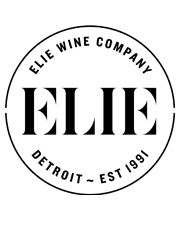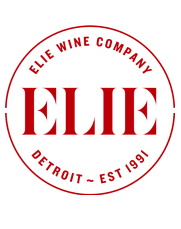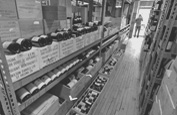New Energy in the Less Familiar Territory of Touraine in The Heart of The Loire Valley; A Place Where Talented Artisanal Vignerons are Introducing Changes and Reinvention. Two Packs: Red Touraine 11-Bottle Pack ($369) & White Touraine 12-Bottle Pack ($369)
Touraine may not grab the vinous headlines of, say, Sancerre or Vouvray, but in ways it is the aesthetic paradigm for the region: Made of castles and gardens and vineyards lining the capricious and majestic Loire from Anjou in the west to Sologne in the east, Touraine winds its way through communes in Indre-et-Loire and Loir-et-Cher.
As part of the Paris Basin, the terroir here is a blend of flinty clay, alluvial river gravel and the unique chalky, fine-grained limestone known as ‘tuffeau.’ White to yellowish-cream in appearance it contains trace levels of mica, and is in part responsible to the longevity of the wines it produces.
There’s more: Since the life of a natural vigneron is often about withdrawing from much of the socio-financial contract of modern urban life, it’s natural that many have sought out the lesser known Loire heartland—Touraine—to set up shop. Not only that, but there is also a generational change among the historic estates, where a new generation of ecology-conscious heirs have revamped old techniques with a new respect for the earth.

Thirst-Quenching Wines to Slake Summer Thirst
Capable of producing prestigious wines with promising futures, Touraine is also the home of wines which can kiss warm weather with the cool embrace of simplicity. These are beautiful representations of their varietals, produced in a style that emphasizes the lyrical, rather than the contemplative side of wine. They are also priced at a point in which you require no occasion more special than this afternoon to enjoy them.
And despite a common misconception, we’re not talking about white wines exclusively. Reds have carved out their own niche in Touraine, and the ones that serve summertime best are those low in alcohol and cooled to a refreshing temperature.
Orange wine is also produced here—see the entry below.
Upriver in Touraine: A Multitude of Soils and Grape Varieties
The vineyards of Touraine grow at the crossroads of oceanic and continental influences, and likewise, the soils are as varied as the breezes, being predominantly limestone, sand and siliceous clay from the Paris Basin, while the terraces bordering the Loire and the Vienne contain deposits of pebbles smoothed to roundness by the action of the water. Such variety supports a cornucopia of grape varieties and multifarious styles—easy-drinking white, red and rosés and sparkling wines along with sweet wines that will bend your mind as they crumble your molars. Whether red, white or shades between, Touraine wines are always vibrant with acidity and delicate, precise flavors.
Known locally as known locally as Pineau Blanc de la Loire, Chenin accounts for much of Touraine production; they are dry, fairly firm, lively and full, and keep well when bottled. The sparkling wines are allowed to use the designation Touraine mousse (sparkling Touraine wine). Up to 20% of Chardonnay grapes may be included in the mixture of varieties grown.
Red wine is produced from Cabernet Franc, Cabernet Sauvignon, Côt, Pinot Noir, Meunier, Pineau d’Aunis and Gamay grape varieties and tend to be firm.

Talented Artisan Vignerons in Touraine: A Quiet Revolution
Land at bargain basement prices in the Garden of France? Touraine, bolstered by the presence of the SAFER group (which controls the sale of agricultural land) is so welcoming to newcomers that it seems an obvious destination for new artisanal winemakers looking to make their mark. This is not a new phenomenon; the AOP has been attracting new waves of natural winemakers since the 1990s.
In fact, so flexible has the region been for young iconoclasts leaning toward experimentation that a new dilemma has arisen: How to find the ideal style and substance to best showcase Touraine’s remarkable terroirs? Ancient varieties like Pineau d’Aunis have retained a foothold while standbys like Sauvignon Blanc are being shifting to supporting roles. As always, tuffeau and flint produce a compelling expression of Chenin—one that is edgier and more bracing than elsewhere—and as these wines grow more popular, another quandary may loom among these talented freshmen (and freshwomen): How can they avoid becoming a monoculture appellation driven by financial success where everyone is chasing the same thing?

Red Touraine 11-Bottle Pack ($369) and White Touraine 12-Bottle Pack ($369)
A Touraine travelogue in wine, covering the best of our collection. This package showcases the revolution in style and substance that keeps Touraine at the forefront of innovation, and where (in a growing world of multinational wine companies) winemaking remains a family affair.
Coteaux-du-Loir
Limited to 22 communes in a rather obscure viticultural whisper just to the north of Touraine, Coteaux-du-Loir produces from a scant 180 acres of vines. The appellation is classified as part of the Loire Valley group even though it does not lie in the valley itself. In fact, the river it follows is the Loir, not the Loire, inevitable confusions notwithstanding.
52% of the vineyards are red wine varieties (primarily Pineau d’Aunis) but of most interest to wine lovers is the whites made from Chenin. They may vary from bone dry and steely to incredibly sweet—honey-scented botrytized wines that bear a passing resemblance to Savennières and Vouvray, although they generally lack the richness and finesse of these better-known wines.
Maison Gazeau-Baldi
(Coteaux-du-Loir)
Perched atop the Jasnières hillside in Lhomme, Maison Gazeau-Baldi is home to Aurély and Jean-Damien, whose modest 20-acre vineyard—currently in the midst of conversion to organic and biodynamic agriculture—has been making quality waves throughout their small appellation. The couple has been able to extract remarkable character from Chenin, Gamay, Côt and Pineau d’Aunis.
Organics is a concept on which the couple has entirely bought into. Says Aurély: “We seek balance in order to think of the vineyard as an ecosystem rather than a material. We work clay soils to obtain a filtering texture while freeing the vine from its competitors. The manure is mainly of animal origin; we prefer cow. We carefully select the buds, and sulfur and copper treatments are minimal and always combined with plant extracts. The harvest is entirely manual, with systematic sorting. The harvest is an opportunity to live a moment of sharing and meetings.”

Jean-Damien and Aurély Gazeau-Baldi, Maison Gazeau-Baldi
Jean Damien adds, “It’s a philosophy that carries through to the cellar. We value the potential of each plot, according to the vintage, then deliver an interpretation by choices of pressing, maceration, racking and aging time, without ever copying a process. We strive to listen to the directions taken by wine and adapt to them. The use of sulfur is minimal and antiseptic in principle. We gladly expose wines to oxygen with the idea of strengthening them. We are in the first year of organic conversion with the ECOCERT organization—labels are, above all, a way to make our practices more readable for consumers and partners. We plan to continue our approach with biodynamic certification.”
 1 Maison Gazeau-Baldi, 2022 Coteaux-du-Loir Rouge ‘Pineau d’Aunis’ ($33)
1 Maison Gazeau-Baldi, 2022 Coteaux-du-Loir Rouge ‘Pineau d’Aunis’ ($33)
80% Pineau d’Aunis, 20% Côt from vines ranging from 5 to 70 years old. The d’Aunis sees whole bunch maceration with regular punch-downs for 20 days; the Côt is directly pressed. The wine pours a light red color and exhibits raspberry and strawberry mixed with earth and spice highlighted with a touch of pepper. Chilled for 15 minutes or so, it is a delightful companion for a charcuterie board. 11,000 bottles produced.
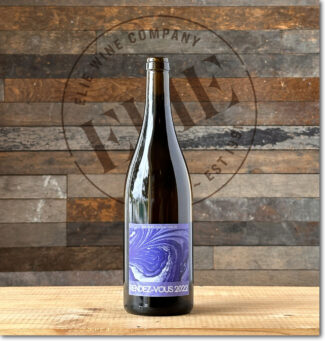 1 Maison Gazeau-Baldi ‘Rendez-Vous’, 2022 VdF Loire-Atlantic Blanc ‘Chenin’ ($25)
1 Maison Gazeau-Baldi ‘Rendez-Vous’, 2022 VdF Loire-Atlantic Blanc ‘Chenin’ ($25)
100% Chenin Blanc crafted from vines less than 10 years old; this is an extremely limited production of 7,000 bottles. Having undergone a meticulous vinification process involving gentle pressing and cold settling, the wine shows fresh peach, grapefruit and a solid saline core.
Touraine Azay-le-Rideau
Even smaller in size than Coteaux-du-Loir, Azay-le-Rideau stretches over eight communes on the banks of the Indre and the Loire, close to where the rivers meet. A mere 148 acres, the terroir is mostly flinty clay, clay limestone and Aeolian sand mixed with clay, and whereas the Chenins are strikingly mineral with strong notes of quince and apricot, most of Azay’s production is rosé, produced by law with a minimum of 60% Grolleau, either vinified alone or blended with Gamay, Malbec and/or Cabernet Franc.
Domaine Marie Thibault
(Touraine Azay-le-Rideau)
“I grew up in the Loire Valley, but unlike many vignerons working in the Loire, I did not come from a winemaking family,” says Marie Thibault, adding, “But also unlike many of them, I have degrees in both biology and oenology.”
Marie Thibault began making wine in the early 2000s, working for a time with François Chidaine in Montlouis, where she fell in love with Chenin Blanc. In 2011, she founded her own nine acre estate on a single windy slope in Azay-le-Rideau, a lesser known commune of Touraine. She immediately converted to organics and has been certified with Ecocert since 2014. Among the natural elements in her vineyards is the flock of two dozen ewes that graze between the vine rows during the autumn; every ten days, they are penned inside a new hectare to keep the soil naturally fertile and the grass clipped.

Marie Thibault
“My vineyard is small, but the soils are extremely varied and as such, so are the grapes I grow. I work with Côt (Malbec), and have a special love for Gamay, Grolleau, Chenin and Sauvignon Blanc. Most of my vines are at least 50 years old. I compensate for small production by purchasing from organic estates nearby, especially those owned by my family.”
 2 Domaine Marie Thibault ‘Les Grandes Vignes’, 2018 VdF Loire-Touraine Rouge ‘Gamay’ ‘natural’ ($41)
2 Domaine Marie Thibault ‘Les Grandes Vignes’, 2018 VdF Loire-Touraine Rouge ‘Gamay’ ‘natural’ ($41)
Thibault’s unique lens on Gamay is seen in this example produced from 50+ year-old vines she discovered growing adjacent to her plot on flinty silex soil. The vines were untrained and un-trellised, and harvest was exceptionally labor-intensive. She allows a 10-month maceration in order to shows off the Gamay’s savory side, with crisp rhubarb, earthy red berry notes and fine-grained, well-integrated tannins showcased.
 3 Domaine Marie Thibault ‘Le Grolleau’, 2021 VdF Loire-Touraine Rouge ‘natural’ ($89) 1.5 Liter
3 Domaine Marie Thibault ‘Le Grolleau’, 2021 VdF Loire-Touraine Rouge ‘natural’ ($89) 1.5 Liter
A wine whose heritage is perfectly reflected in Thibault’s scant acres—Azay-le-Rideau is ground zero for Grolleau, first planted in early 19th century. ‘Le Grolleau’ is an ultra-fresh example made using Beaujolais-style carbonic maceration and held to a little over 10% abv, which solidly qualifies it as a ‘vin de soif.’ It is made using 60-year-old organic vines planted on hillsides on the southern slopes of the Indre—an early-ripening terroir filled with draining soils with a presence of flint, and bottled at the Estate in April 2022 without fining or filtration and just a micro-dose of sulfur. This wine is kept even fresher en magnum; it is fruity, juicy and velvety with sweet cranberry, blueberry, red plum, blueberry, cranberry, a touch of pepper with black cherry on the finish.
 2 Domaine Marie Thibault ‘Premier Nez’, 2019 VdF Loire-Touraine Blanc ‘Chenin’ ‘natural’ ($42)
2 Domaine Marie Thibault ‘Premier Nez’, 2019 VdF Loire-Touraine Blanc ‘Chenin’ ‘natural’ ($42)
A dry, mineral driven Chenin from 40-year-old vines. The wine is spiced with dried orange peel, anise, a touch of pine resin and ripe pear.
Touraine-Chenonceaux
Incorporating 27 communes located on both sides of the Cher River between Tours and Selles-sur-Cher, Touraine-Chenonceaux boasts soils designed to produce spectacular Sauvignon Blanc—clay with flints (with or without a covering of sand) and alkaline clay from the tuffeau limestone ridges. These tend to be intensely aromatic wines with notes of white flowers, ripe citrus and tropical fruit, full-bodied and imbued with a lingering finish.
Red wines, made from Cabernet Franc and Côt, are distinctive and elegant and suggest notes of fruit compote, anise and menthol. Concentration is key, and yields in Touraine-Chenonceaux are limited to 60 hectoliters per hectare for white wines and 55 hectoliters per hectare for red wines. Vineyards are planted on slopes running east-west to benefit from the region’s ample sunshine.
Clos Roussely
(Touraine-Chenonceaux)
Clos Roussely was once a lowly outbuilding of the great fortification at Angé-sur-Cher and as it happens, its five-foot-thick tuffeau walls serve to insulate the winery as efficiently as they once held off Attila the Hun. Not only that, but the 250-year-old hand-dug caves beneath it are ideal for aging the remarkable wines of Vincent Roussely. The transition from barn to vignoble began in 1917, when Anatole Roussely became the first of four generations to dedicate his life to detail; Vincent Roussely, his great-grandson, today works this remarkable terroir—22 acres of clay and limestone peppered with pockets of silex.
“It was my childhood dream to work these soils,” says Roussely, who inherited the estate in 2001. “The terroir is ideal for Sauvignon Blanc, which makes up about 80% of our plantings, but at the heart of Roussely is a small plot of old-vine Gamay. We also have Côt (Malbec), Pineau d’Aunis and a little Cabernet Franc. We have always farmed organically, both for the health of the vines and out of social responsibility, but we were officially certified in 2007.”

Vincent Roussely
The old-school methodology runs through every aspect of the winemaking process. Grapes are hand-harvested and are subject to slow, natural fermentation in the cool catacombs; Gamay undergoes the familiar Méthode Beaujolais, partial carbonic maceration in which some whole grapes are kept intact and begin alcoholic fermentation within the confines of their skins.
Evolving from tradition to technology, Roussely continues to experiment, using concrete eggs for some of his fermentations. “Innovative adaptation means more than simply exploring new techniques,” he says. “It also involves a commitment to ecological responsibility. Right now, about 65% of Loire Valley vineyards are organic and it’s our goal to see that number at 100% by 2030.”
 3 Clos Roussely, 2022 Touraine-Chenonceaux Blanc ($25)
3 Clos Roussely, 2022 Touraine-Chenonceaux Blanc ($25)
Made from 100% old-vine Sauvignon Blanc grown in organic vineyards, the wine emits a bouquet of white flowers, citrus and lemon curd with exotic tropical fruits to shore up a bracing acidity.
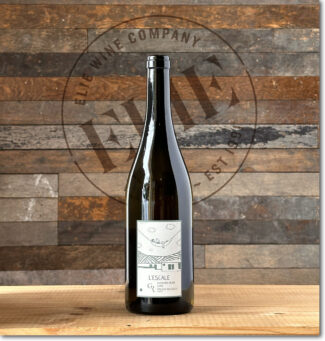 4 Clos Roussely ‘L’Escale’, 2023 Touraine Blanc ($20)
4 Clos Roussely ‘L’Escale’, 2023 Touraine Blanc ($20)
A Sancerre-styled Sauvignon Blanc minus the price tag, this wine shows grapefruit, lime and lots of tropical fruit with a long, mineral driven finish. Although ‘l’escale’ means ‘the stop over,’ this is a wine that invites you to linger while you’re there.
 4 Clos Roussely ‘Canaille’, 2021 VdF Loire-Touraine Rouge ‘Gamay’ ($17)
4 Clos Roussely ‘Canaille’, 2021 VdF Loire-Touraine Rouge ‘Gamay’ ($17)
‘Canaille’ is the French word for ‘scoundrel.’ 100% Gamay from vines between 25 and 50 years old grown organically on clay and limestone. Aged six months in stainless steel, the old vines add a striking depth to this exuberant Gamay, replete with notes of crushed raspberry, black cherry and nutmeg.
Orange is the New Red
Orange wine is an interesting style subset whose popularity has grown in tandem with the natural wine movement, although even within that space, orange wine has a niche all its own. In the Loire (as elsewhere), red wine is made by leaving crushed grapes in contact with their skins as they ferment. White wine is generally made without skin contact during fermentation… unless it’s destined to be orange wine, which is (essentially) white-skinned grapes crushed and fermented on the skins, which imparts eye-catching amber, copper and often orange tints.
Orange wines offer a different sort of bridge between red and white wines than rosé; tannin is generally more obvious and flavors are, like many natural wines, an acquired taste which may be likened to hay, bruised apples, dried apricot, and yes, even orange peel.
 5 Clos Roussely ‘Orange’, 2023 VdF Loire-Touraine ‘Sauvignon’ ($19)
5 Clos Roussely ‘Orange’, 2023 VdF Loire-Touraine ‘Sauvignon’ ($19)
Although winemakers and sommeliers are quick to point out that ‘orange’ refers to the color, this is another example of a skin-macerated Sauvignon Blanc that sends out vibes of orange pith along with apricot and earthy minerality. The wine is a painstaking labor of love, aged 6 months in stainless steel, neither yeasted, nor chaptalized, nor fined.
Cheverny & Cour-Cheverny
Around 40 Cheverny wine growers produce slightly under 3 million liters of red, white and rosé wines each year from 1500 acres of vineyards located in Cheverny itself and in 23 nearby parishes on the southern banks of the Loire. Reds are based on Gamay and Pinot Noir, while Cabernet Franc and Côt (the local name for Malbec) can play supporting roles. They are early-drinking wines best consumed within two years of vintage.
Whites are a combination of Sauvignon Blanc and Sauvignon Gris with lesser proportions of Chardonnay, Chenin and Arbois (here spelled ‘Orbois’) allowed. Although these wines have been compared to the Sauvignons of Sancerre and Pouilly-Fumé, they lack the distinctive minerality and searing acidity that defines the eastern Loire’s two most-famous appellations.
Cour-Cheverny is a unique wine region located within the Cheverny appellation; it produces white wines made only from the rare grape variety Romorantin. Romorantin is an old Burgundian grape now only grown in Cour-Cheverny—wines are herbal, showing apple and pear behind Acacia flowers. They are also ripe for aging, and mature, Romorantin develops aromas of honey, lemon and beeswax.
Domaine Hervé Villemade
(Cheverny & Cour-Cheverny)
Hervé Villemade is where he belongs; at the helm of a family estate: “My grandparents founded the domain and I took over in 1995. At the time there were 8.5 hectares of rather young vines (15-20 years) that my grandparents had planted. The farm used to be in polyculture and the old vines from the 1960’s had been removed to plant new ones in the 1970’s. When I took over, I replanted five hectares and started renting some vines as well. I’ve also bought land over the years and today we find ourselves working 25 hectares—eight are mine, 8.5 are my parents’ and the rest is rented.”
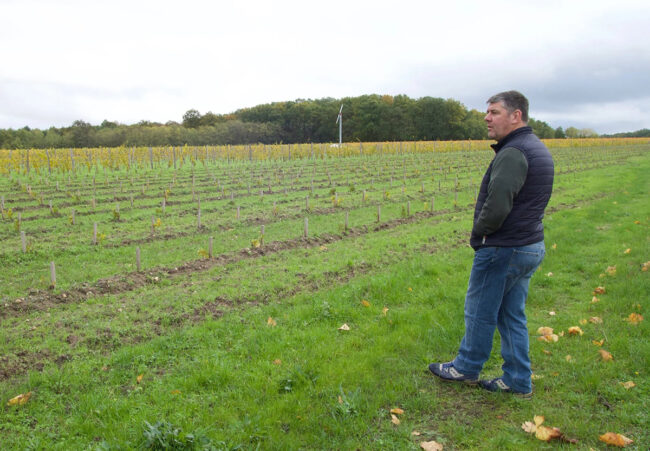
Hervé Villemade
When Hervé first took the reins, the entire estate was farmed conventionally, with chemicals in the vineyards. Unaware of the alternatives, he followed in his parents’ footsteps until he became very bored with end results: “The wines were uninspired and bland,” he says. “Around this time I was introduced to wines that were different, that spoke to me, that struck a chord emotionally: Natural wines. Coincidentally, at the exact same time that I was discovering these wines I started developing a very serious allergy to sulfur. This was around 1997. My first attempt at sulfur free winemaking was two years later. What I hadn’t realized, and what I quickly found out (through Marcel Lapierre in particular), was that to make sulfur free wine, you needed clean grapes. From that point I immediately started converting the entire estate to organic agriculture and have worked this way ever since.”
 6 Domaine Hervé Villemade ‘Les Ardilles’, 2022 Cheverny Rouge ($37)
6 Domaine Hervé Villemade ‘Les Ardilles’, 2022 Cheverny Rouge ($37)
85% Pinot Noir, 15% Gamay from sandy clay soils with silex over limestone—produced only in exceptional vintages. Maceration lasts 20 days with moderate punching down, following which the wine is aged in tuns, barrels, truncated conical vats and amphorae. Crunchy red fruit and balanced acidity display Villemade’s signature style—an extreme purity of fruit.
 7 Domaine Hervé Villemade, 2022 Cheverny Rouge ($26)
7 Domaine Hervé Villemade, 2022 Cheverny Rouge ($26)
40% Gamay and 60% Pinot Noir macerated (80% whole-cluster and 20% destemmed) for 15 to 20 days. It is fermented and aged in concrete and wooden ‘tronconique’ vats without pump-overs, pigeage, racking or filtration. The wine shows bright red fruit, especially black cherry with and slightly spicy and glossy touches.
 8 Domaine Hervé Villemade ‘Bovin’, 2022 VdF Loire-Touraine Rouge ‘Gamay’ ($28) 1 Liter
8 Domaine Hervé Villemade ‘Bovin’, 2022 VdF Loire-Touraine Rouge ‘Gamay’ ($28) 1 Liter
Hand-harvested, 100% Gamay from vines between 40 and 60 years old grown in the Cher Valley. The grapes are macerated for 10 days in concrete with intervention, then bottled using a minimum of sulfur for stability. The wine is ripe and crunchy with red fruit and displays the lighthearted ease that the label suggests.
 9 Domaine Hervé Villemade, 2022 VdF Loire-Touraine Rouge ‘Gamay’ ($25)
9 Domaine Hervé Villemade, 2022 VdF Loire-Touraine Rouge ‘Gamay’ ($25)
100% Gamay from the Cher Valley, the wine is aged in wooden vats without human intervention until it is bottled without filtration. The wine shows aromas of red fruits, candied blackberries with a hint of cinnamon behind balanced mineral notes and a silky finish.
 5 Domaine Hervé Villemade ‘La Bodice’, 2022 Cheverny Blanc ($38)
5 Domaine Hervé Villemade ‘La Bodice’, 2022 Cheverny Blanc ($38)
80% Sauvignon Blanc, 20% Chardonnay; La Bodice is a single vineyard wine that combines tropical fruit and herbaceous citrus.
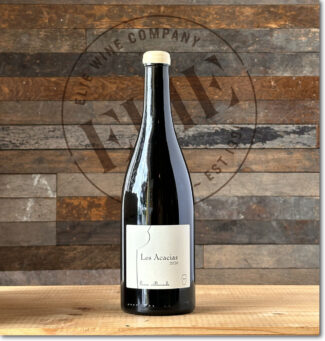 6 Domaine Hervé Villemade ‘Les Acacias’, 2020 Cour-Cheverny Blanc ($50)
6 Domaine Hervé Villemade ‘Les Acacias’, 2020 Cour-Cheverny Blanc ($50)
100% Romorantin, aged 50% in amphorae and 50% in demi-muids for 23 months. It shows a luscious and complex nose filled with white flower along with touches of honey and five-spice powder. The palate echoes the nose, with a mineral backbone and hints of smoke.
Famille Percher
(Cheverny & Cour-Cheverny)
Perhaps the most interesting parcel farmed by Luc Percher (of Famille Percher) is ‘La Marigonnerie’ directly adjacent to the winery. In Napoleon times the vineyard area was a pond, and although the region sits on a bed of limestone sprinkled with granitic sand, the pond left behind a bed of clay which, about 120 years ago, was planted to Romorantin—a local white wine variety with its own appellation (Cour-Cheverny) where it is the only grape permitted.
Luc began making wine here in 2005. “When I arrived, the sand was as white as a beach. I fell in love with the ambience—a few wispy trees and an expansive horizon-line. It is quiet terroir.”

Luc Percher
His 22 acres of vines, tended with certifications from BIO and Déméter, is hardly restricted to Romorantin, although only his 100% Romorantin can be labeled Cour-Cheverny. His Sélection Massale old-vine vineyards contain ten different grape varieties, and some even more rare than Romorantin—Menu-Pineau, Gamay Fréaux and Chaudenay, for example. In order to maintain the biological heritage of these grapes, Luc is committed soil maintenance, through hilling, stripping, scratching and the establishment of controlled natural grassing. “These practices are respectful of the earth, the plants and the environment; they support the development of biodiversity and preserve the terroirs. You no longer see the white sand between the vine rows—it is covered by grass and other vegetation. We echo that philosophy in the cellar, being minimalist on the interventions in order to more faithfully reflect the grape varieties and the purity of place.”
 10 Famille Percher, 2019 Cheverny Rouge ($36)
10 Famille Percher, 2019 Cheverny Rouge ($36)
A 50/50 blend of Pinot Noir and Gamay grown on sandy clay with a limestone base. It is fermented with indigenous years and spends 15 days macerating before élevage in stainless steel on fine lees. It shows a frisky nose of black cherries and cassis with an edge of earth—graphite, tree bark, espresso and forest floor. Tannins are moderate and the finish is long.
 7 Famille Percher, 2019 Cheverny Blanc ($36)
7 Famille Percher, 2019 Cheverny Blanc ($36)
60% Sauvignon Blanc, 40% Menu Pineau from sandy, clay limestone soils. Fermentation is done on indigenous yeasts with élevage in stainless steel and bottled without fining or filtering. Menu Pineau is the local name for Arbois and in Cheverny produces wine characterized by low acidity, apple aromas and a delicate, mineral substructure.
 8 Famille Percher, 2020 Cour-Cheverny Blanc ($46)
8 Famille Percher, 2020 Cour-Cheverny Blanc ($46)
You won’t experience many wines made from 120-year-old vines, but this one comes from Percher’s oldest parcel. 100% Romorantin showing a bouquet of honeysuckle and acacia and an intensely mineral-driven palate of pear, apple skins and honeycomb.
Le Petit Chambord
(Cheverny & Cour-Cheverny)
“The wines of François Cazin are wines of purity, minerality and a sweet-sour vibrancy that makes my mouth water for more. I have no doubt that he is one of the leading vignerons in the appellation, along with Michel Gendrier, Michel Quenouix, Laura Semeria and Christian Tessier, among one or two others. Indeed, I am sure there are some who would place him at the very top.”
François Cazin works with approximately 50 acres of vineyards; three-quarters in the Cheverny appellation, while the rest is are in the Cour-Cheverny appellation. As this latter appellation only amounts to about 125 acres in its entirety, François Cazin is cultivating about 10% of the entire appellation, where his Romorantin vines average over 30 years old.
In his Cheverny and Crémant-de-Loire acres he tends Pinot Noir, Gamay, Sauvignon Blanc and Chardonnay, as well as small parcels of Côt and Menu Pineau. The Gamay and Sauvignon Blanc tend to be planted on more sandy-clay soils, while clay and limestone is favored for Pinot Noir.

François Cazin, Le Petit Chambord
“Everything in my Cour-Cheverny vineyard has to be done manually because of solid coat of limestone directly underneath the superficial soil,” Cazin says, championing his old-school endeavors. “Some of these vines are older than my dad; they were planted by my grandfather. It goes without saying that these are 100% in Massale, and they are in better shape than the vast majority of my other vines. For example, the clonal selection on the other side of the house is much younger, but there is way more mortality.”
 11 Le Petit Chambord ‘Vendanges Manuelles’, 2022 Cheverny Rouge ($23)
11 Le Petit Chambord ‘Vendanges Manuelles’, 2022 Cheverny Rouge ($23)
Pinot Noir/Gamay/Côt from estate vines averaging thirty years old and grown on clay-limestone soils. The Pinot Noir is destemmed and macerated for a week while the Gamay is whole-cluster fermented semi-carbonically; the small bit of darker, more tannic Côt (aka Malbec), adds a touch of color and structure.
 9 Le Petit Chambord ‘Vendanges Manuelles’, 2023 Cheverny Rosé ($21)
9 Le Petit Chambord ‘Vendanges Manuelles’, 2023 Cheverny Rosé ($21)
A blend of Gamay and Pinot Noir, made with both direct-press and saignée methods; each parcel is vinified individually in stainless steel and élevage takes place in enamel-lined concrete tanks with pre-bottling blending.
 10 Le Petit Chambord ‘Vendangé à la Main’, 2023 Cheverny Blanc ($22)
10 Le Petit Chambord ‘Vendangé à la Main’, 2023 Cheverny Blanc ($22)
82% Sauvignon Blanc,18% Chardonnay; the wine shows a nice balance of Chardonnay’s roundness and buttery fruity notes and fresh citrus notes of Sauvignon Blanc.
 11 Le Petit Chambord ‘Vendanges Manuelles’, 2021 Cour-Cheverny Blanc ($24)
11 Le Petit Chambord ‘Vendanges Manuelles’, 2021 Cour-Cheverny Blanc ($24)
100% Romorantin from vines between 40 and 90 years old. The wine shows orange blossom, candle wax, pear and lemon peel.
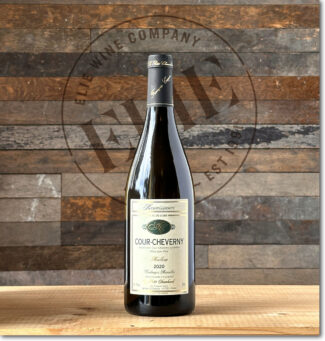 12 Le Petit Chambord ‘Renaissance – Vendanges Manuelles’, 2020 Cour-Cheverny Blanc ‘Moelleux’ ($27)
12 Le Petit Chambord ‘Renaissance – Vendanges Manuelles’, 2020 Cour-Cheverny Blanc ‘Moelleux’ ($27)
‘Moelleux’ indicates sweetness, although it often highlights the fattiness inherent in the grapes. In this one, the harvest is direct pressed and fermented in stainless steel, then later, cold stabilized with an addition of sulfur to keep sugars in the wine and block fermentation. Élevage is done in 300-liter barrels for six months, then in underground vats until the following spring. It offers a symphony of apricot, honey and quince with a balanced acidity that lingers on the palate.
Notebook …
Vin-de-France (VdF): Should I Stay, or Should I Go?
Created in 2009 as a category of wine meant to encourage both experimentation and exploration, this label designation means only that the grapes were grown in France. The quality (or, perhaps, lack thereof) does not stem from its region of origin or a strict set of specifications, but in the freedom it offers winemakers and winegrowers to get their creative juices flowing.
By eschewing the rules and regulations of the location-based Appellation d’Origine Contrôlée (AOC) or Indication Géographique Protégée (IGP), VdF allows innovation among winemakers who wish to grow varieties not permitted within their particular region and who relish to freedom to produce creative, boundary-pushing wines.
The plusses are obvious: Vin de France-labeled wines are generally much more affordable than their AOC counterparts, and may serve as entry points to an estate’s terroir-driven, higher-end selections without the matching price tags.
The downside (if any) is that the VdF designation is marketed directly at drinkers who are intimidated by the elaborate, geography-grounded system that many of us love and consider the defining feature of our fascination with the subject. Many Francophiles, both in the United States and abroad, believe that any major change to the French wine system meant merely to sell more bottles at the expense of tradition sort of misses the point of the entire artform.
- - -
Posted on 2024.07.25 in Touraine, Coteaux-du-Loir, Cheverny, Coteaux-du-Loir, Cour-Cheverny, Touraine Azay-le-Rideau, France, Wine-Aid Packages, Loire | Read more...
A Veritable Revolution in Sancerre: Stéphane Riffault is Creating Wines of Texture, That are Singular, and True to Themselves. (Seven-Bottle Pack $299: Two Red and Five White)
A communion with the soil is the most important relationship a winemaker will ever forge, and nowhere is this demonstrated more reliably than in Sancerre, where three distinct soil types produce a split-personality of wine characteristics. This may be something of well-kept secret, as the name ‘Sancerre’—even to experienced wine drinkers—often exists as a single, all-encompassing concept limited to crisp, bone-dry, citrus-scented Sauvignon Blancs.
Sancerre, as it happens, is a wealth of subtleties from commune to commune, vineyard to vineyard, lieu-dit to lieu-dit, just as it is in Burgundy.
In this week’s exploration, we’ll take a look at the portfolio of one of Sancerre’s most innovative young winemakers, Stéphane Riffault, owner of Domaine Claude Riffault, who works 33 different parcels and eight different lieux-dits spread across four villages. Riffault’s cross-section of Sancerrois splendor is a nice overview of the triumvirate of soils as well Stéphane’s mastery of balancing minerality and wood—a feat rarely duplicated anywhere else in the appellation.
Sancerre: Sauvignon Blanc is Only Part of The Story
Rumors that Sancerre is synonymous with Sauvignon Blanc have been greatly exaggerated. That said, no credible wine scholar will deny that the stars aligning between Sancerre’s terroir and the blonde scioness of the Val de Loire is a remarkable gift to us all. Just as the Loire River runs through the heart of France, Sancerre pierces the heart of summertime and Sauvignon Blanc grown among the brush, gravel and layers of Cretaceous soils provides an unadorned synthesis of the scents we associate with the easy season: Cut grass, Meyer lemon, tart hedgerow berries and petrichor—the incomparable aroma of raindrops on stone.

80% of the grapes grown in Sancerre are Sauvignon Blanc, so it is no wonder that this varietal dominates the market, especially in the United States. But nearly 20% is Pinot Noir, and it’s a fact that prior to phylloxera, Sancerre was best known for its red wines. Not only that, but in that not-so-distant past, the whites were rarely made from Sauvignon Blanc, but from Chasselas, which is still grown in small pockets.
When the diabolical little phylloxera louse decimated the vineyard of Sancerre (along with much of Europe) they were replanted with Sauvignon Blanc, which was more responsive to the requisite remedy—American root stock.
One thing did not change: The almost clichéd emphasis Sancerre places on purity. This is a result of two factors: First, the region is relatively far north, so a hallmark of nearly all Sancerre—red, white or pink—is its bright acidity—preserved in the grapes by cool nights and temperate days. The pH of a wine determines its mouthfeel, and the higher the acidity, the more sizzling is the sensation of freshness and clarity on the palate, often described as ‘purity.’
Of equal importance, very little oak is used in the maturation process of wines from Sancerre, and the flavors associated with oak—butter, clove, vanilla and caramel—however desirable in Burgundy—tend to mask some of the fruit-driven notes. It’s one of the reasons that oak-free Chablis is considered the purest incarnation of Chardonnay, and likewise, the neutral barrel or stainless steel/cement aging of Sancerre’s Sauvignon Blanc, Pinot Noir and occasionally Gamay offers the best results for preserving the natural flavors inherent in the juice.
Soil Matters: Sancerrois Trilogy
Every cliché-driven wine writer on the planet will tell you that in order to make superb wine you must begin with superb grapes, and every conscientious winemaker on earth will tell you that to grow those grapes you need superb soil. And few appellations the size of Sancerre (roughly 7000 acres) are more narrowly defined by three unique variations on that theme, and this is a point of pride for Sancerre’s winegrowers.

First, are the silex soils, which extend southward from Saint-Satur to Thauvenay. Silex soils contain flint (‘silex’ is what the British call this sedimentary form of quartz); such soils form over millennia as limestone erodes to dust and much harder stones are left in its wake. Flint leaves an interesting imprint on Sauvignon Blanc; the wines are elegant and finely-etched with distinctive citrus and herbal notes, but most prominent is the spark/smoke character that the French call ‘pierre à fusil’—literally, gunflint. The smoky minerality that is so prized in tasting notes is far more evident in silex soils than those chalkier wines grown in limestone—silex wines attain a nearly indefinable quality of precision, like the edge of an arrowhead.
Next is the Kimmeridgian marl found on Sancerre’s westernmost hills (as well as in Chablis Grand Crus and many great Champagne terroirs). It is a mixture of limestone and clay that formed eons ago as the final resting place of the famous comma-shaped oyster, Exogyra virgula. Their fossilized shells (quite visible in many stones from the region) left the soils rich in calcium carbonate. Amazingly, wines from this prehistoric graveyard produce wines in which the now-evaporated sea—in the form of a briny undertow, or saltiness—can clearly be tasted. Kimmeridgian marl is known locally as ‘terres blanches’ because the chalky clay turns white in dry periods.
Sancerre’s Oxfordian limestone soils are perhaps less heralded but they are arguably more important because they produce the bulk of the ‘entry-level’ early-drinking Sancerres that—in the public perception—may better typify the region. That is not to say that, in the right hands, they cannot produce wines of great subtlety, as proven by Stéphane Riffault, whose Sury-en-Vaux estate sits (in part) on a ribbon of Oxfordian. These are stone-filled soils, but unlike silex soils, there’s little flint and unlike Kimmeridgian, there is little clay. Instead, the rocky subsurface is filled with two distinct types of stone, caillottes, which are sizable pebbles and Griottes, which are much smaller. Oxfordian limestone tends to run north-south from Sainte-Gemme down through Bué and below.
Domaine Claude Riffault
Le Métronome*
*From ‘Our 25 Domaines of the Year,’ Guides des Vins 2020, Bettane+Desseauve:
“When you think of Sancerre, you absolutely have to mention Stéphane Riffault. Measure, attention and reflection forge high-flying and stylish cuvées; each reflecting the personality of its terroir. Everything here exudes excellence.”
When Stéphane Riffault took over Domaine Claude Riffault from his father Claude, he brought with him a tool kit earned in a number of contrasting appellations, having studied and trained with Olivier Leflaive in Burgundy and at Château Angélus in Bordeaux. This broader view informed the core, hands-on education he received from his father at the domain. Among the rather ‘un-Sancerre-like’ methods he brought to the estate was hand-harvesting and extensive sorting before the crush; Stéphane’s wife Benedicte leads the harvest team while Stéphane manages the sorting and press during harvest.
Meanwhile, among the conclusions at which he arrived on his own is that sustainability is key to the future. As such, all 33 of his vineyard acres are organic (Ecocert, 2016) and biodynamic (Biodyvin, 2021).
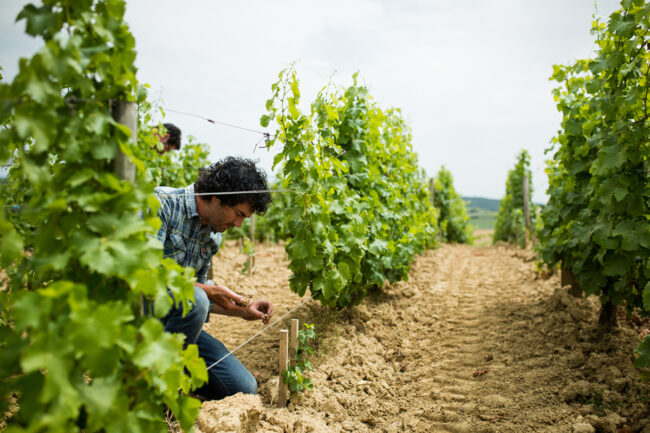
Stéphane Riffault, Domaine Claude Riffault
All good winemakers seem to be equal parts dirt-farmer and metaphysical philosopher, and Stéphane is no exception: “Being a winegrower and winemaker demands commitment, risk and continual self-questioning,” he maintains. “You have to know how to adapt in order to stay dynamic. Improvement requires perpetual movement, and what drives me is the creation of wines of texture; wines that are singular and true to themselves.”
Although most of the Riffault’s holdings are planted on the soft limestone soil called ‘terres blanches’, he farms a handful of parcels on caillottes and silex; thus, he has developed a keen understanding of the qualities that each unique terroir brings to an individual wine. He employs oak moderately to add length to his already-precise, site-expressive and highly delineated bottlings.
All his parcels are vinified separately, and (except for the rosé), all are bottled unfiltered.
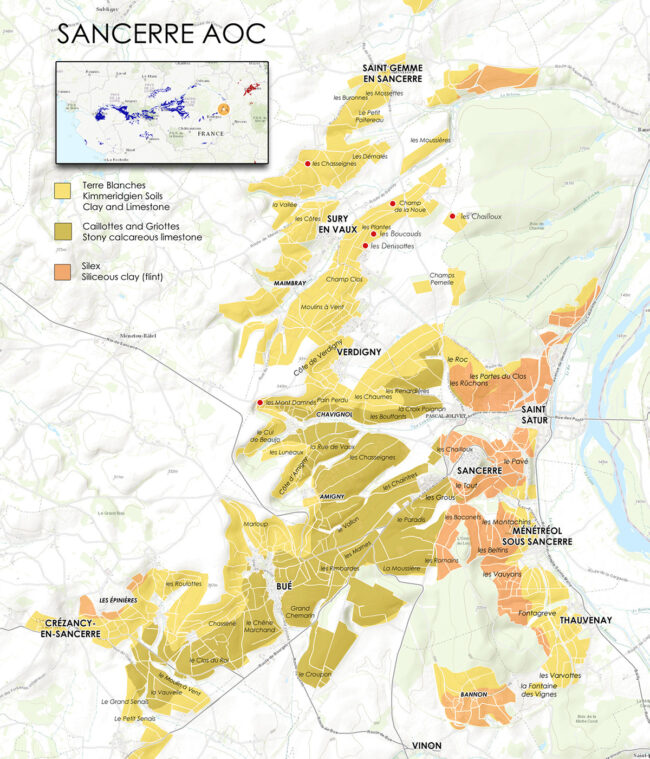
White Sancerre: Lieux-dits Tell Their Story
As someone trained in Burgundy (and whose brother Benoît is the winemaker at Domaine Etienne Sauzet in Puligny-Montrachet), you might expect Stéphane Riffault to have a particular affinity for lieux-dits—those unique parcels of vineyards so singular in expression that they have their own names. This is absolutely the case, and there is more: The Crus of Burgundy may be well-mapped and understood, but far less so are the vineyards and lieux-dits of Sancerre. Riffault considers them among France’s finest terroirs, able to produce great white wines not of stature and complexity, but of individual identity. As such, he is making it his mission to champion eight parcels among the 33 plots he currently works as part of an exacting showcase stratospheric Sancerres seen from a near-microscopic perspective.
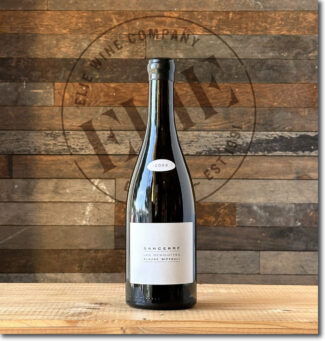 Domaine Claude Riffault, 2022 Sancerre ‘Les Denisottes’ Blanc ($49)
Domaine Claude Riffault, 2022 Sancerre ‘Les Denisottes’ Blanc ($49)
Les Denisottes is a three-acre plot located near Riffault’s Sury-en-Vaux estate and is composed of three individual southeast-facing plots at nearly a thousand feet in altitude. The vines (between 40 and 50 years old) are rooted in deep Kimmeridgian limestone. The juice fermented spontaneously and was aged on lees for 14 months in multi-layer wooden barrels with sporadic bâtonnage and no malolactic fermentation, producing a wine loaded with citrus zest, green apple tartness and a distinct flinty minerality.
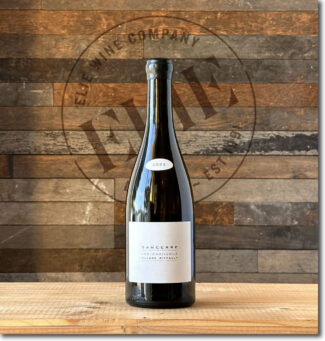 Domaine Claude Riffault, 2022 Sancerre ‘Les Chailloux’ Blanc ($49)
Domaine Claude Riffault, 2022 Sancerre ‘Les Chailloux’ Blanc ($49)
Les Chailloux is a unique site in the village of Sury-en-Vaux. While silex soils are common in the neighboring Pouilly-Fumé and the eastern edge of Sancerre, it is fairly scarce in the northwestern part of Sancerre. Stéphane Riffault farms about three acres of vines in this lieu-dit, which produces concentrated and opulent wine, yet racy and intensely saline and capable of aging gracefully for many years.
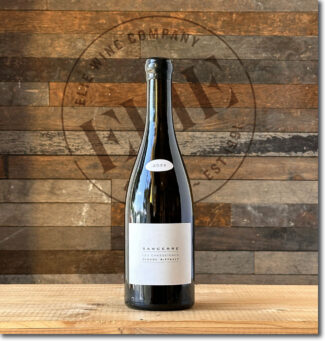 Domaine Claude Riffault, 2022 Sancerre ‘Les Chasseignes’ Blanc ($44)
Domaine Claude Riffault, 2022 Sancerre ‘Les Chasseignes’ Blanc ($44)
Les Chasseignes is an east/southeast facing lieu-dit that sits at nearly 900 feet in altitude. Planted on gravelly limestone soils, the wine opens with a greenish, refreshing bouquet and gains considerably in complexity upon aeration, becoming round and elegant and finishing with savory notes.
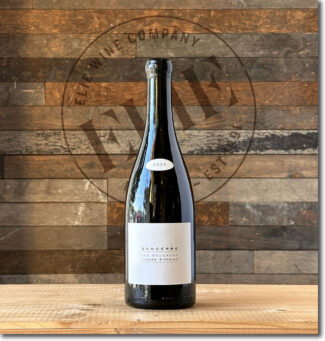 Domaine Claude Riffault, 2022 Sancerre ‘Les Boucauds’ Blanc ($40)
Domaine Claude Riffault, 2022 Sancerre ‘Les Boucauds’ Blanc ($40)
From a top parcel in Sury-en-Vaux; the 2022 Boucauds is a blend of both Burgundy barrels (several from Etienne Sauzet in Puligny-Montrachet) and larger oak formats. Because of the deep clay and limestone soils, Les Boucauds always has great mouthfeel and depth, as opposed to Stéphane’s silex and caillottes parcels which are more linear and austere in their youth. Sourced from several Les Boucauds plots, this cuvée employs close to half of all the Sauvignon Blanc planted on the estate.
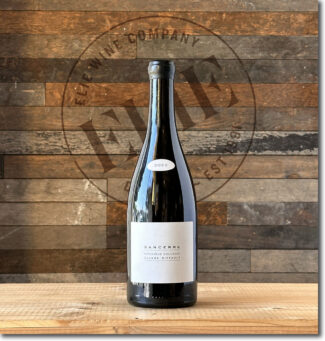 Domaine Claude Riffault ‘Mosaïque Calcaire’, 2022 Sancerre Blanc ($39)
Domaine Claude Riffault ‘Mosaïque Calcaire’, 2022 Sancerre Blanc ($39)
In 2018 Stéphane Riffault made the decision to release a village-level Sancerre after additional plantings on limestone terroirs that he has undertaken over the last decade. It also includes some fruit from Les Boucauds and Les Chasseignes along with eighteen other parcels. Like all good Sancerre, this wine is supple and nearly succulent, filled with tropical notes besides the melon and pear foundation. It is rich, but remains light on its feet behind gentle acidity.
Red Sancerre: Taking Cues from Burgundy
To look for a silver lining amid the global catastrophe of climate change is nearly sacrilegious—unless you are a fan of red wine from Sancerre. Despite its strong history in the appellation, red wine grapes (Pinot Noir, almost exclusively) once struggled to ripen, and when they did, did so erratically. In all but exceptional vintages, Sancerre reds had a reputation for being thin and somewhat weedy, and even the alchemy of elite producers like Domaine Claude Riffault tended to produce wines with obvious bell pepper notes—a telltale signature of under-ripe red grapes, and an issue that oak does not fix.
In 2014, a warming climate began to put some of these nagging problems in the rearview mirror. The growing season was not necessarily longer, but the diurnal temperature shifts—vital for maintaining a useable balance between sugars and acids—allowed Pinot Noir to ripen more completely and more evenly. The wisest producers began to rely on a Burgundian approach; vinifying individual parcels by terroir, relying on blends that may vary from year to year, and perhaps most importantly, rethinking the use of oak barrels, allowing them to accent rather than submerge the fruit.
And every year, the fruit is proving itself reliably worthy, showing the rich black cherry and cola notes lifted by acidity that we have come to expect in top Burgundies.
All this does not meliorate the downside of climate change, but if life hands you lemons, might as well become better acquainted with Sancerre’s now world-class Pinot Noirs.
 Domaine Claude Riffault, 2019 Sancerre ‘La Noue’ Rouge ($38)
Domaine Claude Riffault, 2019 Sancerre ‘La Noue’ Rouge ($38)
La Noue is a six-acre plot of Pinot Noir on planted on Kimmeridge limestone, and here, Riffault’s Burgundian-trained touch is evident. The enticing tea like, garrigue-infused fragrance is followed by raspberry, blueberry and violet notes enrobed in silky tannins. As with all wines from Domaine Claude Riffault, the vines are cultivated according to organic and biodynamic guidelines. Manual harvesting is followed by 18 months of ageing. Total production amounts to 10,630 bottles.
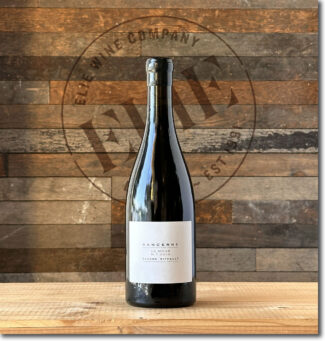 Domaine Claude Riffault ‘M.T. Mise Tardive’, 2019 Sancerre ‘La Noue’ Rouge ($48)
Domaine Claude Riffault ‘M.T. Mise Tardive’, 2019 Sancerre ‘La Noue’ Rouge ($48)
‘Mise Tardive’ refers to a process in which the unbottled wine undergoes a longer élevage with extended lees aging. Divided into seven plots and ranging in age from 10 to 60 years old, Noue is the source for both Noue Rosé and Rouge. Stéphane’s Rouge shows his Burgundian-trained touch with this variety, one that preserves the light and delicate style of Pinot from Sancerre, but layered with a depth of red fruit and black tea flavors.
RECENT ARRIVAL
Chavignol’s Damned Mountain: The Geography of Sancerre Writ Large
Mohammed was a teetotaler, but if he’d been a Sancerre lover and he had to go to the mountain, it would have been Chavignol. With apologies to Francis Bacon, who came up with the proverb about Mohammed and mountains in 1625, Chavignol looms above Sancerre as a Kimmeridgian limestone and marl billboard for the heights that this wine can reach.
It’s notable that in Sancerre (unlike the Médoc and Burgundy), the appellation system has no officially designated Premier Cru or Grand cru vineyards, based in part on a local reluctance to emphasize individual hamlets or specific lieux-dits sites that might divert consumers from the easily identifiable Sancerre brand. Chavignol remains an exception to prove the rule: Inhabitants of this eponymous village have long marketed wine under the name ‘Chavignol,’ and still mention it on the labels of their Appellation Contrôlée Sancerre wines. This is not simply the obligatory inclusion of their address, but a subtitle which takes on such dimensions that the name of Sancerre is eclipsed.
Located just a few minutes’ drive to the west of Sancerre, Chavignol is home to two of the appellation’s most famed lieux-dits, Les Monts Damnés and Le Cul de Beaujeu, which are together responsible for some of the region’s most sought-after wines.
Domaine Thomas-Labaille
Claude Thomas continued to work old vines in Monts Damnés—Sancerre’s greatest vineyard site—until well into his seventies, just as he maintained his standards in the cellar with élevage in old foudres and unfiltered bottlings. He clung to traditions in the hope that his daughter and son-in-law would ultimately take the reins.
This finally happened when Jean-Paul Labaille quit his civil servant job and became a full-time vigneron—although for the previous ten vintages, he had taken his vacation during the harvest to be the assistant winemaker to Claude Thomas. Few changes have happened under the new guard, and the 27 acres of vineyards remain among the best in Chavignol, with a large proportion of old vines. The oldest barrels have been re-placed by newer, mostly second-hand barrels that are 2 to 3 years old. The goal at Thomas-Labaille has always been to avoid any oaky character, but to let the wine breathe as it evolves slowly on its lees.
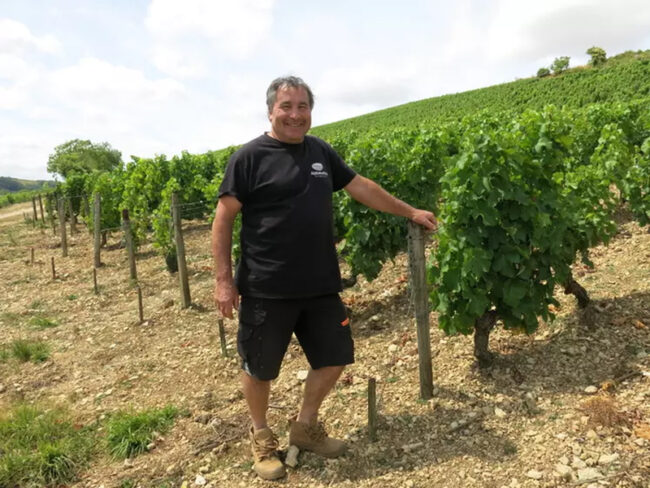
Jean-Paul Labaille, Domaine Thomas-Labaille
Work in the vineyards still follows Claude Thomas’ time-honored techniques, though through necessity as much as through respect: Monts Damnés is too steep a slope to ever consider machine harvesting—now the norm in the appellation—but the site is so spectacular that it’s worth the trouble. Many of the vines are over 80 years old; a genuine rarity in Sancerre. Given such spectacular raw material it’s no wonder that the resulting wine remains sensational: Rich, fat, round, with layered aromas, and marathon finishes. These are not a typical bistro Sancerres, but graceful wines meant for aging.
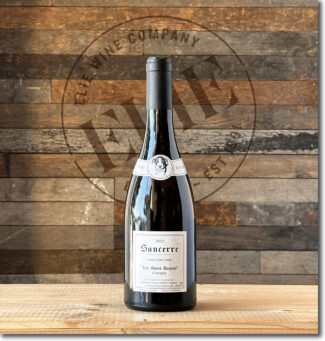 Domaine Thomas-Labaille, 2022 Sancerre – Chavignol ‘Les Monts Damnés’ ($46)
Domaine Thomas-Labaille, 2022 Sancerre – Chavignol ‘Les Monts Damnés’ ($46)
100% Sauvignon Blanc fermented on native yeasts in fiberglass and cement, then aged on lees in stainless steel tanks (with a small proportion of old barrels in some vintages) for four to six months and bottled without filtration. The nose shows a bit of citrus and nectarine with hints of guava; the palate is weighted and luscious, and the wine finishes with a delineation and minerality reminiscent of a top Chablis, a hallmark quality of Monts Damnés.
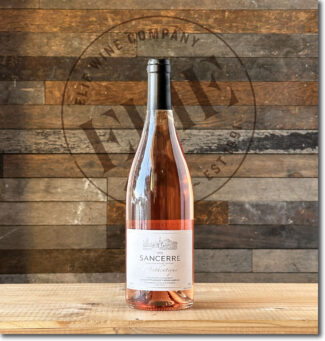 Domaine Thomas-Labaille ‘Cuvée L’Authentique’, 2023 Sancerre Rosé ($30)
Domaine Thomas-Labaille ‘Cuvée L’Authentique’, 2023 Sancerre Rosé ($30)
Jean-Paul also makes a younger, fresher wine that is released earlier than Monts Damnés and is meant for immediate consumption. Formerly bottled as straight ‘Sancerre,’ for the past few vintages, it has been labeled as ‘Cuvée l’Authentique.’ This wine is sourced from all the estates’ vineyards, and shows high-toned citrus fresh grasses and forest floor but is dominated by its stoniness.
Vintage Journal in Centre-Loire
The 2022 Vintage
Directly from the journal of Jean-Paul Labaille:
“Following the terrible frost that impacted our crop in 2021, it almost feels like 2022 was blessed from above. While it’s true that drought and hail impacted many vineyards this year and that the heavy rainfalls in June made it very challenging to work the soils, in the end the vines were balanced and we did not suffer the same amount of hydric stress felt by so many other regions. We even had some light rain in August and at the very beginning of harvest, giving us grapes of great quantity and quality. We began on September 5th, interrupted once on the 7th by a hail storm that touched the Northwest of the appellation. In Chavignol there were zero impacts. Qualitatively, we are in for a good vintage. The fermentations have been going well, with pH levels between 3.2 and 3.3, permitting us to keep a good amount of freshness. The alcohol will end up between 12.5 and 13.5, maybe as high at 13.7 on the Monts-Damnés. 2022 really reminds me of 2018, which is very promising!”
The 2020 Vintage
Temperatures in Central Loire began to warm up in the second half of February, setting the stage for the season and giving the vines an early start. In mid-March to mid-April cold nights caused some vignerons to us mobile anti-freeze towers and light braziers to warm the vines, and in the end, there was very little frost damage. Flowering went very well and thanks to dry weather there was virtually no mildew. But this dryness became a concern during the summer and blocked the ripening process in mid-August. Rain finally arrived at the end of August which allowed the vines to start producing again, reducing the gap time between phenolic and physiological maturities. The harvest took place in sunny dry weather and the vintage achieved both quantity and quality.
The 2019 & 2018 Vintages: The Twin Years
The back-to-back vintages 2018 and 2019 represent something of a climactic miracle. Even as a stand-alone, 2018 is considered to be one of the most exceptional vintages seen in the region for half a century. Taken together with a spectacular 2019, they are twin towers of triumph.
2018 began with fantastic spring that allowed for successful flowering and fruit set without any of the usual problems that normally occur with rain, hail or frost, and a hot summer developed the ripe semi-tropical flavors associated with the best Sauvignon Blanc. 2019 was a bit cooler, but produced grapes where the coveted acids that reign in aggressive fruit notes.
Tapping the source directly, Vacheron comments, “2018 and 2019 are very similar in the way they are constructed, even if the alcohol is slightly higher in 2018. The two vintages tend to show that it is possible to make wines that have good freshness despite low acidities because the minerality superseded the acidity. 2018 is without a doubt a vintage that will mark people’s memories, and will remain a reference in Sancerre. It’s the kind of vintage that helps grow a heightened generation of wine makers within their appellations.”
Notebook …
Wine Siblings: Sancerre and Chablis
Brothers from another mother or sisters from another mister; either way, the land beneath Sancerre and Chablis springs from the same prehistory. Classified in the middle of the 18th century by French geologist Alcide d’Obigny while he was working near the English town of Kimmeridge, he identified a unique layer of dark marl and called it ‘Kimmeridgian.’
Still, as in siblings, there are distinct differences in the DNA of English Kimmeridgian and French Kimmeridgian. The French layer is a relatively uniform chalky marl with thin limestone containing rich layers of seashells. This is because strata formed from the post Jurassic period continued to be deposited in the shallow sea areas which once covered part of France. The way these layers interact is key to the reason that French Kimmeridgian soils produce some of the world’s most heralded wine. The marly soil provides good structure, ideal water-retention and is easy to cultivate while hard limestone Portlandian contains numerous fossil fragments and, having been repeatedly shattered by frost, offers good aeration and ideal drainage along gentle slopes.

Chablis is a significant part of the Kimmeridgian chain; mid-slope vineyards in Chablis match almost perfectly to the Kimmeridgian outcrop, with the soft, carbonate-rich rock being covered by Portlandian limestone and supported by other limestone deposits. Sancerre, meanwhile, sits on top a fault ridge; the eastern side has a layer of Cretaceous soils while the west side is covered with brush and gravel slopes. Further west the best vineyards sit on the classic Portlandian-Kimmeridgian soil combination, producing a classic example of ‘terroir’.
- - -
Posted on 2024.07.20 in Sancerre, Rosé de Loire, France, Wine-Aid Packages, Loire | Read more...
The French Climate Divide: 2023 Rosés Show The Difference Between Warm-Climate (Mediterranean) and Cool-Climate (Oceanic) Fruit. Ten Types, Spanning the Two, by Seventeen Producers. A Dozen Rosés $349 – A Holiday Sampler.
Two things that France and the United States share: A red, white and blue flag and a passion for rosé. So, while we’re celebrating both on the Fourth of July, we’ll take the opportunity to offer a springboard to this style via through a series of rosés that span France from north to south.
Tastes in wine run hot and cold and so do the climates that produce them. Nearly every commercial vine on earth is grown between 30° – 50° latitude (both north and south), but that range offers an almost endless array of rainfall patterns, cloud covers and wind configurations and such a wide spectrum of environments and that generalization seems pointless. And yet, anyone qualified to blind taste with authority should be able to tell you very quickly whether the wine comes from cool or warm region simply by gauging the character of the fruit.

In cool climates, where budding occurs late and frosts arrive early, even grapes harvested at optimal ripeness tend to produce lighter, more acidic wines with flavor profiles that lean toward savory herbs and acidic fruits like cranberries and tart cherries. In fact, you’ll find these types of descriptors used for wines made from any number of varieties that have adapted to cooler climates. In contrast, warm weather and extended growing seasons in the world’s southerly vineyards results in jammier, richer wines with less acidity and darker fruit flavors (blackberry and plum), often underscored with exotic aromatics like coffee and chocolate.
Nowhere is this climate divide more obvious than in France, and no style of wine demonstrates it better than French rosé, a wine with many guises. A versatile food wine and a cherished part of French viticulture, crisp, cheerful rosé is produced both in France’s frosty north and sultry south with characteristically different, yet equally spectacular results.

Mediterranean Climate
Provence and Southern Rhône Valley Rosé
With the same passion as its red and white cousins, rosé raises the flag of diversity and complexity in an infinite combination of terroir, grape variety and vintage variation. If you still consider it a pale, pink, lightly alcoholic swimming-pool tipple, have we got a surprise for you!
Hugging the Mediterranean between Spain and Italy and blessed with consistently fine growing condition, Southern France produces wines ideally suited for this summery milieu. Despite its location France, the vineyards are still far north of almost all of Spain and Italy’s, so the days are long during the growing season, allowing grapes to fully ripen. The Gulf Stream and Mediterranean Sea keep it balmy while steady winds banish humidity that can cause disease and mildew.
As such, the reds are particularly robust, and these grapes, of course, are the foundation of the pinks.
The 2023 Vintage
Drought was the name of the 2023 game, and the Mediterranean coast experienced it badly, sometimes halving harvest volumes. Although vines can survive scorching heat, they tend to produce less juicy and more acidic grapes. But every region has its variations. The vines in Roussillon, for example, suffered severe water stress throughout the season whereas those in Languedoc experienced an ‘episode cévenol’—a storm specific to the south of France—in September. Despite these extreme conditions, the vines’ tough, deep roots were able to draw on unexpected resources to ensure that the grapes continued to grow and the overall harvest, while smaller than normal, looks promising.

Côtes-de-Provence
The massive Côtes-de-Provence sprawls over 50,000 acres and incorporates a patchwork of terroirs, each with its own geological and climatic personality. The northwest portion is built from alternating sub-alpine hills and erosion-sculpted limestone ridges while to the east, and facing the sea, are the volcanic Maures and Tanneron mountains. The majority of Provençal vineyards are turned over to rosé production, which it has been making since 600 B.C. when the Ancient Greeks founded Marseille.
Château Les Mesclances
Côtes-de-Provence
In the Provençal dialect, ‘Mesclances’ refers to the confluence of rivers, and the estate, a mere two miles from the sea in the commune of La Crau, is situated between two streams, the Réal Martin and Gapeau, which originate in the limestone massif of the Sainte Baume. The property consists of 75 contiguous acres and is a picturesque ideal of Mediterranean culture and pretty rolling topography. And certainly, this geography determines appellation status: Wines from the estate’s plain are IGP Méditerranée while the foot of the slope yields AOP Côtes de Provence, and the steeper incline of the hill carries the rare Appellation Côtes de Provence ‘La Londe’. Only 20 estates count La Londe in their holdings.
Mesclances is owned by Arnaud de Villeneuve Bargemon, whose family has run the domain since the French revolution. In April 2018, Alexandre Le Corguillé joined the team as estate manager, and as is to be expected, most of the vineyard production is dedicated to rosé.
 1 Château Les Mesclances ‘Faustine’, 2023 Côtes-de-Provence ‘La Londe’ Rosé ($36)
1 Château Les Mesclances ‘Faustine’, 2023 Côtes-de-Provence ‘La Londe’ Rosé ($36)
La Londe is a tiny sub-appellation of the Côtes-de-Provence spread between the communes of Hyères and La Londe-les Maures itself, as well as some specific areas of Bormes-les-Mimosas and La Crau. 75% of the production is rosé made from Cinsault and Grenache, bolstered by up to 20% of various red and white varieties, including Tibouren, Syrah, Mourvèdre and Vermentino, known locally as Rolle.
Mesclances’ La Lond is a serious, age-worthy rosé that blends 90% Grenache and 10% Mourvèdre from the estate’s blue-schist soils, fermented spontaneously, with the Grenache given 15 hours of maceration and the Mourvèdre derived from the saignée method.
Bandol
Conventional wisdom has taught us that wine grapes fare best in places where nothing else will grow; rocky, water-starved soil on precipitous hillsides make vine roots work harder, ramifying and branching off in a search of nutrients and, in consequence, producing small grapes loaded with character. Cue Bandol, the sea-and-sun-kissed region along the French Riviera, which is not only good country for grapes, it’s good country for the soul. Made up of eight wine-loving communes surrounding a cozy fishing village, Bandol breaks the Provençal mold by producing red wines that not only outstrip the region’s legendary rosé, but make up the majority of the appellation’s output. In part that’s due to the ability of Bandol vignerons to push Mourvèdre—generally treated as a blending grape in the Côtes du Rhône and Châteauneuf-du-Pape —to superlative new heights.
Domaine La Bastide Blanche
Bandol
Michel and Louis Bronzo purchased Bastide Blanche in the ‘70s in the belief that the terroir could produce a wine to rival those of Châteauneuf-du-Pape. With that in mind, the brothers planted Carignane, Cinsault, Clairette, Grenache, Mourvèdre and Syrah. Vintage 1993 proved to be their breakaway year, putting both Bandol and themselves on the wine map.
The estate is located in the foothills of Sainte-Baume Mountain, five miles from the Mediterranean Sea on land that is primarily limestone scree.
 2 Domaine La Bastide Blanche, 2023 Bandol Rosé ($31)
2 Domaine La Bastide Blanche, 2023 Bandol Rosé ($31)
Predominantly Mourvèdre shored up with Grenache and Cinsault, this cuvée is full-bodied from direct-press and shows orange citrus, watermelon, herbed cherry and some lengthy minerality.
Cassis
The entire vineyard area of Cassis is under five hundred acres, but most of the properties overlook the sea, which moderates the heat and creates an ideal climate for vine growing; the commune is known primarily for its herb-scented white wines, principally from Clairette and Marsanne (about 30% of Cassis production is rosé) and despite its name, it does not produce Crème de Cassis.
Domaine Bagnol
Cassis Rosé
Sitting just beneath the imposing limestone outcropping of Cap Canaille 700 feet from the shores of the Mediterranean, Domaine du Bagnol is the beneficiary of the cooling winds from the north and northwest and as well as the gentle sea breezes that waft ashore. Cassis native Jean-Louis Genovesi and his son Sébastien run the 18-acre estate.
 3 Domaine Bagnol, 2023 Cassis Rosé ($37)
3 Domaine Bagnol, 2023 Cassis Rosé ($37)
45% Grenache, 35% Cinsault and 20% Mourvèdre. A taut, acidic, sea-dominated rosé from a handful of parcels totaling 17 acres planted in clay and limestone on a gentle north-northwest-facing slope. It shows the characteristic salinity of a coastal vineyard with supple nectarine and melon notes.
Côtes-du-Rhône
Côtes-du-Rhône is one of the largest single appellation regions in the world, covering millions of acres and producing millions of bottles of wine of varying degrees of quality. In Southern Rhône, it encompasses the majority of vineyards and includes hallowed names like Gigondas, Vacqueyras and Châteauneuf-du-Pape.
The latter wines prefer to use their individual, highly specific ‘Cru’ names, but the truth is, many generic Côtes du Rhônes may come from plots just outside official ‘Villages’ boundaries—some only across the road or a few vine rows away from top vineyards—and among them, you can find wines with nearly the same level of richness at a fraction of the cost.
Domaine Charvin
Côtes-du-Rhône Rosé
Established in 1851, Domaine Charvin is one of the region’s perennial superstars. Laurent is the sixth-generation Charvin to run the domain, and the first to commercially market a proprietary bottling. He tends vines in the northwest end of Châteauneuf-du-Pape, primarily in Cabrières, Maucoil and Mont Redon, farming organically and engaging in old-school vinification, without de-stemming and fermenting in concrete tanks for 21 months before bottling without filtration.
 4 Domaine Charvin, 2023 Côtes-du-Rhône Rosé ($24)
4 Domaine Charvin, 2023 Côtes-du-Rhône Rosé ($24)
45% Grenache, 45% Cinsault, 10% Mourvèdre showing up-front notes of candied cherries, strawberry, lavender and Provençal herbs.
Oceanic Climate
Loire Valley Rosé
Established in 1974, Rosé de Loire is an official appellation that covers rosé made in the Loire Valley region of western France. Broadly speaking, the appellation follows the wider Loire River valley from Blois in the east, almost to Nantes, on the Atlantic coast in the west, covering the same lands as Touraine, Saumur and Anjou but stopping on the border with Muscadet.
Obviously, such a wide swath of land is varied in terrain and geography, from the shale-based vineyards in Anjou to the undulating chalk and tuffeau hills of Saumur and Vouvray. Touraine itself boasts a wide variety of soil types (including clay-limestone, clay-flint, as well as sand or light gravel on tuffeau. Climatically, the region is heavily influenced by water, with the Loire River and its tributaries moderating both very warm and very cold weather while the Atlantic Ocean (Bay of Biscay) to the west is the origin of much of the weather patterns in the area.
Only Cabernet Franc, Cabernet Sauvignon, Gamay, Grolleau, Grolleau Gris, Pineau d’Aunis and Pinot Noir are permitted in Rosé de Loire wines. The blend (or single variety) used is at the discretion of the winemaker.
The 2023 Vintage
The Loire suffered a hit-and-miss 2023. The winter was relatively mild and rolled into an equally benign spring without cataclysmic frost. Budburst was largely successful, and the gently rising temperatures proved idyllic for flowering, with yields promising to be high. June, however, hot and humid and aggravated by frequent rain; disease pressure ran high. Producers had to frequently spray and those who weren’t vigilant lost yields. That said, the heat pushed the grapes to phenolic ripeness signaling an early harvest.
Although some parts of the valley were struck by several fierce heatwaves, nights were cool enough to preserve both acidity and aromatics.

Sancerre
Sancerre in a nutshell—or rather, an oyster shell—boils down to the sea. Sancerre’s terroir is built on the remnants of the vast primordial ocean that once covered the hills and valleys of northern France and deposited calcium-rich shells from ancient, oyster-like sea creatures. This is ideal soil for the two grapes for which Sancerre is justly famous, primarily Sauvignon Blanc and to a slightly lesser extent, making up about 20% of the output, Pinot Noir and its attendant rosé.
A ‘typical’ rosé from Sancerre is created by allowing the Pinot Noir to macerate on the skins for a short period of time, generally between two and 20 hours, lacing the wine with a deeply layered nose featuring elegant green citrus, sweet floral notes, passion fruit and fresh green herbs. A semi-tannic structure, which is prized in these rosés, usually means they are better after a year or two in the bottle.
Like its red-blooded parent, rosé made from Pinot Noir has a natural affinity for food, and is a perfect foil for the rich cheese produced throughout the appellation.
Domaine Pascal & Nicolas Reverdy
Sancerre Rosé
The oyster-shell limestone of Sancerre, called Kimmeridgian, forms the base soil beneath the tiny hamlet of Maimbray, located in a valley surrounded by chalk hills of Chavignol and Verdigny. Across 43 acres of this vital terroir, Pascal Reverdy and his wife Nathalie (alongside Nicolas’s widow Sophie) combine tradition with trajectory: Now, sons Victorien and Benjamin shore up the team. Having completed his DNO at Dijon, with stints at Armand Rousseau (Gevrey-Chambertin), Châteaux Léoville Las Cases and Beychevelle (St Julien) and Christine Vernay (Condrieu), Victorien returned first in 2019. Benjamin reappeared in the summer 2023, having cut his teeth at Domaine de la Romanée Conti.
Pascal, who founded the winery in 1993, explains the family’s mandate: “We are about 70% planted with Sauvignon Blanc and 30% with Pinot Noir. Hard pruning keeps yields low, with vineyard being grassed through, and lutte raisonnée being practiced. Harvesting is by hand and we have built a reputation across white, red and rosé Sancerres, with no oak ageing, as well as three special cuvées (Les Anges Lots, La Grande Rue and à Nicolas) which are barrel aged.”
 5 Domaine Pascal & Nicolas Reverdy ‘Terre de Maimbray’, 2023 Reverdy Sancerre Rosé ($32)
5 Domaine Pascal & Nicolas Reverdy ‘Terre de Maimbray’, 2023 Reverdy Sancerre Rosé ($32)
The ‘Terre’ in the name is ‘blanche’—the ‘white earth’ of Sancerre’s classic terroir. From three acres of 30-year-old Pinot Noir grown in characteristic clay-limestone, direct-pressed and vinified in demi-muids (10%) and stainless steel tanks (90%), the wine shows a bouquet of ripe strawberries and red grapefruit underpinned by earthy tones that still allows bright acidity to sparkle through.
Domaine Roger & Christophe Moreux
Sancerre Rosé
Established in 1895, with winegrower roots extending back to the 16th century, work in the Moreaux’s 22 acres has been handed down across many generations. Today, following the retirement of his father Roger, responsibility rests with Christophe Moreaux.
Located in the tiny hamlet of Chavignol (population 200) along the Upper Loire River where they are renowned equally for their wine and their cheese—Crottin de Chavignol has its own appellation. Wine, however, is the passion of Christophe, who says, “We believe we are in possession of some of Sancerre’s greatest terroirs, the vineyards of Les Monts Damnés and Les Bouffants.”
Moreaux production is a scant 65,000 bottles per year, with about one quarter of it made from Pinot Noir, both red and rosé; it is fermented in stainless steel and aged for six to eight months before release.
 6 Domaine Roger & Christophe Moreux ‘Cuvée des Lys’, 2023 Sancerre Rosé ($27)
6 Domaine Roger & Christophe Moreux ‘Cuvée des Lys’, 2023 Sancerre Rosé ($27)
A lightly structured rosé with a distinct herbal edge; ripe with aromas of apricots, cherries, currants, and wild strawberries supported by vibrant acidity.
Domaine Pierre Morin
Sancerre Rosé
Gérard Morin took over the family’s vineyards about twenty years ago and, while making some of the most striking wines in Sancerre, he prepared his son Pierre to run the show. Pierre, who once worked the vineyards of Adelaide Hills, saw little in Australia worth emulating in Sancerre. He now helms the estate with an eye toward maintaining a house style typical of Bué (about a mile and a half from the village of Sancerre): rich, aromatic whites and some particularly deep reds that are best matched, according to Pierre, to “an andouillette cooked in the vineyard on vine prunings, ideally for breakfast.”
The Morin’s vines are planted on a steep hard-calcaire amphitheater surrounding the commune of Bué and consist of 17 acres of Sauvignon Blanc and five of Pinot Noir. Yields are held low through spring de-budding (one of Pierre’s few, but significant changes) and all harvesting is done by hand. Fermentation is done by parcel in an air-conditioned chai, in enameled steel vats, with the finished wines left alone on their lees for as long as possible.
 7 Domaine Pierre Morin, 2023 Sancerre Rosé – Bué ‘Les Rimbardes’ ($31)
7 Domaine Pierre Morin, 2023 Sancerre Rosé – Bué ‘Les Rimbardes’ ($31)
Les Rimbardes is situated to the east of Bué, nearly to the border of Sancerre. Soils here are heavy with clay, giving the wines more heft. This fruit-forward rosé offers grapefruit, strawberry, Meyer lemon, and tangerine zest aromas intertwined with rhubarb, lemon and hints of caramel.
Domaine Dominique et Janine Crochet
Sancerre Rosé
The steeps slopes of Bué are also home to winemakers Teddy and Cyprien Crochet, who took over from their father Dominique after his untimely passing. Although Teddy spent time as a rugby player, he remains true to his roots, now five generations deep. Cyprien raves about the holdings in Chêne Marchand, Grand Chemarin, Champ Chêne and the steepest vineyards in the La Côte de Bué: “We like to think that the Crochet name is synonymous with the town of Bué,” Cyprien says, “…one of the three greatest villages in Sancerre. We’re equally proud to be producing Sancerre in a winery our father started in a garage—we are true garagistes making ‘vins de garage.’”
Established in 1992, Dominique and Janine began with a handful of of perfectly situated hillside acres. Today, the domaine extends to nearly forty acres hosting more than forty tiny parcels. Grapes are hand-harvested—a Bué necessity, given the steep hillsides—and indigenous yeast is preferred, especially for the reds, which are treated to light clay filtration before bottling
 8 Domaine Dominique et Janine Crochet, 2023 Sancerre Rosé ($29)
8 Domaine Dominique et Janine Crochet, 2023 Sancerre Rosé ($29)
Grown on silex soils, the wine is attractive in both color and bouquet; salmon pink and perfumed with cherry and rose petal, which is echoed on the palate with juicy citrus accents and culminates in an energetic and crisp finish.
Domaine de Sacy
Sancerre Rosé
In keeping with the theme of these selections—small production, family-owned hamlet wines—miniscule Sacy nestles near Crézancy and Bué; Karine Millet has taken over the family domaine with of vines. Karine practices polyculture, the historical practice in Sancerre, where cow manure from the farm is used throughout the vineyards and sustainable viticulture, without herbicide or pesticide, is the rule of the day. Her vines average 30 years old, with some approaching half a century.
“Our soil is all ‘terres blanche,’” Karine says. “This is a late-ripening terroir made of thick clay layers intertwined with flat, white limestone. It’s rich in fossils that have the particularity of whitening while drying in the sun. Terres Blanches terroir gives a strong aromatic concentration, tension and aging potential to the wines as well as a pronounced mineral character.”
 9 Domaine de Sacy, 2023 Sancerre Rosé ($29)
9 Domaine de Sacy, 2023 Sancerre Rosé ($29)
A beautiful and balanced summer wine offering medley of citrus flavors wrapped in an with an intense bouquet of strawberry, raspberry and red fruit cake. The palate shows solid Sancerre structure with varietal character: spicy red Pinot Noir with a classic hint of watermelon rind and mineral notes.
Menetou-Salon
Menetou-Salon is an AOP in the Centre-Val de Loire with vineyards extending over 820 acres and covering 10 communes, including Menetou-Salon itself. Only 3600 bottles of Menetou-Salon Rosé reach American shores each year, so if you can find it, you are in an exclusive club.
Domaine Philippe Gilbert
Menetou-Salon Rosé
Having felt the pull of the soil, Phillipe Gilbert left his occupation as a successful playwright to take over the family estate in the hamlet of Faucards in the midst of Menetou-Salon. The vineyards are scattered throughout the heart of the appellation in prime sectors of the villages of Menetou-Salon, Vignoux, Parassy and Morogues where the soil is a classic mix of clay and limestone sitting on the famous Kimmeridgian basin.
With the assistance of his colleague, Jean-Philippe Louis, Philippe Gilbert has plunged headlong into the system of biodynamic viticulture and the domaine is now certified as an organic producer.
 10 Domaine Philippe Gilbert, 2023 Menetou-Salon Rosé ($32)
10 Domaine Philippe Gilbert, 2023 Menetou-Salon Rosé ($32)
100% Pinot Noir, Philippe’s standout rosé is pressed directly and fermented spontaneously—a rare practice for the category since most growers want to ensure market-demanded consistency at all costs. It spends six months in steel, undergoing natural malolactic fermentation. Exuberant and energetic, it offers brambly raspberry, white cherry and grapefruit zest interlaced with notes of pulverized chalk and wet river stones.
Chinon
Playwright François Rabelais (a Chinon local boy made good) wrote, “”I know where Chinon lies, and the painted wine cellar also, having myself drunk there many a glass of cool wine.” That wine was likely red: though capable of producing wines of all hues, Chinon’s focus is predominantly red; last year, white and rosé wines accounted for less than five percent of its total output. Cab Franc is king, and 95% of the vineyards are thus planted. Rabelais’ true stage was set 90 million years ago, when the yellow sedimentary tuffeau, characteristic of the region, was formed. This rock is a combination of sand and fossilized zooplankton; it absorbs water quickly and releases it slowly—an ideal situation for deeply-rooted vines.
Château de la Bonnelière
Chinon Rosé
Respect for tradition and love of family are the twin forces that animate Château de la Bonnelière: In 1976, Pierre Plouzeau bought the old family castle and renovated the property while replanting the largely-vanished vineyards. His son Marc took over in 1999 and has become one of Chinon’s most prolific and talented personalities, responsible for a plethora of marvelous juice—red, white and pink. 43 acres of vines and a 1500-square-meter cellar carved out of the castle’s solid stone foundation provide an environment as beautiful as it is fecund.
 11 Château de la Bonnelière ‘M Plouzeau – Rive Gauche’, 2023 Chinon Rosé ($19)
11 Château de la Bonnelière ‘M Plouzeau – Rive Gauche’, 2023 Chinon Rosé ($19)
A cuvée born in the alluvial soils on the left bank of the Vienne, where the sand and gravel terroir produce Cabernet Franc of exceptional freshness. The wine shows crisp minerality and notes of raspberries and peaches.
Rosé-de-Loire
Although rosé production in Loire has expanded markedly in recent years, its commercial origins go back to the early 20th Century when the wines were dubbed ‘Rouget’ in the Anjou and ‘Vin Gris’ in Touraine. Today, they are required to be dry with no more than three grams per liter of residual sugar and cannot have more than 12.5% alcohol-by-volume.
The title covers much of the rosé production in the area although it is worth noting that all the appellations covered by the Rosé de Loire title can produce their own rosé. Both the Saumur and Anjou appellations can make rosé produced from Cabernets Franc or Sauvignon and these must be labeled “Cabernet de Saumur” or “Cabernet d’Anjou” respectively. Additionally, Rosé d’Anjou (another possible rosé title in Anjou) is broadly similar in production requirements to Rosé-de-Loire.
Château Soucherie
Rosé-de-Loire
Perched on a rise overlooking the Layon river, Soucherie is considered one of the most beautiful domains in Anjou. Roger-Francois and Pascal Beguinot have transformed 90 acres of limestone, clay and schist into multiple lieux-dits spread across Anjou, Chaume, Coteaux du Layon and Savennieres. Around the winery, 54 acres are planted on a southern hillside sheltered from the winds; the 11 acres in Chaume contain vines over 70 years old while the four acres in Savennieres (Clos des Perrieres), loaded with shale, produce wines noted for their minerality. Maître de chai Thibaud Boudignon is leading the charge towards 100% organic viticulture through the principles of ‘agriculture integrée’—a ‘whole farm’ management system intended t deliver more sustainable agriculture by combining modern technologies with traditional practices according to a given site and situation.
 12 Château Soucherie ‘L’Astrée’, 2023 Rosé-de-Loire ($27) Gamay
12 Château Soucherie ‘L’Astrée’, 2023 Rosé-de-Loire ($27) Gamay
Cellarmaster Vianney de Tastes hand-harvests this pure Gamay rosé, and shapes the variety into a pale, juicy and dynamic wine by direct pressing and four-months of aging in stainless steel. The wine offers white peach, dandelion greens, sweet basil and pineapple sage.

Semi-oceanic Climate
Champagne’s Coteaux-Champenois Rosé
Côteaux Champenois Rosé is a still Champagne as rare as a five-leaf clover; it is only produced from select, authorized vines, and only in certain vintages, in extremely limited quantities, and by very few Vignerons.
Domaine Fleury
Côte-des-Bar
Although it sounds a bit contradictory, doing what comes naturally’ is often an exacting science and a dedicated quest, and nowhere in Champagne is this more evident than in the fields and cellars of Domaine Fleury, the Côte des Bar foremost champion of ‘The Art of Nature.’
Founded in 1895 in the heart of the Côte des Bar and driven by the terroir of the clay-limestone hillsides formed by the first tributaries of the Seine, Fleury has a storied history in the region, managing to weather both the phylloxera crisis and the market crash of 1929. But according to Jean-Pierre Fleury, it was biodynamics over all else that gave new meaning to Champagne production: “To be respectful of the natural and living heritage of this terroir, where custodians of the land forever learn, in all humility, to perceive the balance and to unearth its mysteries.”
Gone entirely biodynamic by 1992—a time when the concept was foreign to nearly every winemaker in France—Jean-Pierre has passed the spirit of purity and innovation to his children: Morgane Fleury, an actress and sommelier, who has developed a new concept of an ecological wine and champagne bar in central Paris; Jean-Sébastien, also at the heart of innovation at the domain, who is experimenting with grafting techniques in the vines as well as reintroducing horses to work on certain plots; Benoît, who is currently working with massale selection and agroforestry as new ways of cultivating the vines in symbiosis with an adapting environment.
 Domaine Fleury, Coteaux-Champenois ‘Côte-des-Bar’ Rosé ($68)
Domaine Fleury, Coteaux-Champenois ‘Côte-des-Bar’ Rosé ($68)
Comprised of vintages 2017, 2018 and 2019 hand-harvested 35 to 40 years old Pinot Noir vines, fermented spontaneously with low-intervention, bottled unfined and unfiltered. The wine offers a nose of Maraschino cherry, strawberry and lemon zest while the fruit-driven palate had notes of cherry and raspberry behind bright acidity.
Domaine Lelarge-Pugeot
Montagne-de-Reims
In 1985, when Dominique Lelarge took over his family estate, his first order of business was to improve the quality of the soil in the vineyard, and this began with a more sustainable farming approach. To this day, he views the use of pesticide an inherent threat to nature, and treats this understanding as a wake-up call: “Life is a gift from nature,” he says. “Everything starts in the vineyard, so it is important for us to respect what nature handed us.”
Although the Lelarge family has grown grapes in Vrigny since 1799, the last two decades have seen the leadership of the two Dominiques (winemakers and owners Dominique Lelarge and Dominique Pugeot) embrace and encourage diversity in both their ecosystem and in their outlook on Champagne production. Nestled in the Premier Cru village of Vrigny on the Montagne de Reims slopes—a mere 15 minutes west of Reims—their 21 acres are planted primarily to Meunier (11 acres), but a percentage of Pinot Noir (7 acres) and Chardonnay (3.4 acres) also figure into their blended wines.
Certified organic since 2014 and biodynamic since 2017 by Demeter, Lelarge-Pugeot encompasses 42 distinct parcels flourishing at elevations averaging 400 ft.
“We do not make wine so much as we farm vines, meticulously looking after every single step of the growth to produce the most natural Champagne possible.”
 Domaine Lelarge-Pugeot, 2020 Coteaux-Champenois ‘Montagne-de-Reims’ Premier Cru Vrigny Meunier Rosé ($66)
Domaine Lelarge-Pugeot, 2020 Coteaux-Champenois ‘Montagne-de-Reims’ Premier Cru Vrigny Meunier Rosé ($66)
A zéro-zéro cuvée that represents the family’s first ever attempt at making a still rosé made exclusively Meunier. The fruit comes from two parcels of 40-year-old vines with tiny concentrated clusters, which create highly aromatic Meunier showing high-toned notes watermelon, pomegranate, tarragon and salinity.
Continental Climate
Burgundy Rosé
Don’t let its relative lack of press fool you—Bourgogne Rosé is made in 300 communes throughout Burgundy and comes in multiple incarnations; some barbecue basic, others rich and cellar-worthy.
As might be imagined, most Bourgogne Rosé is mad with Pinot Noir, although Gamay is also permitted (there are some made exclusively from Gamay—in fact, if you see a rosé with ‘Mâcon’ and another geographical denomination on the label, the wine must be 100% Gamay). In very rare cases, Pinot Gris (known as Pinot Beurot in Burgundy), Chardonnay and Pinot Blanc turn up in a rosé, at least in part to help manage the wines’ color. In the northern Grand Auxerrois region, the ancient César grape gets to play a supporting role, adding some depth and structure.
The 2023 Vintage
In terms of yield, 2023 was historic—the quantity of healthy grapes grown had not been seen since 1982, and bunches were harvested that weighed double the norm. So copious was the output of Burgundian vineyards that, due to INAO rules, it could not all be harvested. The major producers had to cut 50% of the harvest to meet the normal, optimal 35-40 hl/ha.
With yields like this, it is doubtful that 2023 will go down as a great vintage, but it will certainly produce lively and energetic vintage, which is an ideal scenario for rosé.
Domaine Collotte
(Côte-de-Nuits)
Marsannay Rosé
Located on Rue de Mazy, Marsannay’s ‘high street’, Domaine Collotte shares a headquarters with Domaine Fougeray de Beauclair, owned by a Collotte cousin. Formerly under the control of Philippe Collotte, his daughter Isabelle—having completed her viticulture studies—has joined her father in the domain and specializes in making the family’s superb Marsannay Blancs.
Isabelle entered the business with plenty to work with: Covering about forty acres, mainly in Marsannay but with small plots in Fixin, Gevrey and Chambolle, Domaine Collotte draws mainly from vines over fifty years old and farms one lieu-dit planted in 1947. Among the innovations she has insisted upon involves selling less wine in bulk, which was a practice of her father.
In addition, she has embraced a holistic view of vineyard work: “Plowing is the norm here, no herbicides,” she says. “The grapes are triaged at the winery before 100% destemming into concrete tanks with one week of cool maceration. We love the thermal stability of concrete so there is a little pigeage early in fermentation and later only remontage. The color is ‘fixed’ with a short period at 35°C where the wine slowly cooling in the tank before a pneumatic press and then into barrels.”
Phillipe adds, “The common thread running through Domaine Collotte is an intimate link, our visceral attachment to Marsannay. For over 100 years, each generation of the Collotte family has dedicated its life to this village and its vineyards. Even if some of our parcels are located in Chambolle-Musigny, Fixin or Gevrey-Chambertin, it is in Marsannay-la-Côte that the heart of Domaine Collotte beats. Clos de Jeu, Champ Salomon, Boivin, Grasses Têtes, Combereau are a few of the Climats de Marsannay that plunge us daily into history by domain that is eminently proud of its roots.”
 Domaine Collotte, 2023 Marsannay Rosé ($26)
Domaine Collotte, 2023 Marsannay Rosé ($26)
Isabelle Collotte’s 2023 rosé is sourced a two-acre plot of Pinot Noir; the harvest is sorted as soon as it arrives in the vat room before being pressed directly. The pressing is done on a long cycle and at low pressure for a quality must; static settling is carried out for 24 hours and the wine is vinified in stainless steel tanks. The wine displays aromas of raspberry and tangerine, supported by secondary notes of rose water, rhubarb and anise.
Pierre-Marie Chermette
Beaujolais Rosé
Pierre-Marie Chermette was raised in the vineyard; his fondest memories of the family home in Vissoux was riding the tractor. He pursued it as his life’s work, earning National Diploma of Oenologist from Dijon at the age of 20. Two years later, he convinced his father to stop selling the fruits of his labor to merchants, and developed the market estate bottled wines, increasing the plots who was selling his wine in bulk to merchants. He invests himself fully in the family winery by developing the marketing of bottled wines. Over the years, he diversified the number of appellations the family worked, and is now responsible for nearly 75 acres.
 Pierre-Marie Chermette Vissoux ‘Griottes’, 2023 Beaujolais Rosé ($22)
Pierre-Marie Chermette Vissoux ‘Griottes’, 2023 Beaujolais Rosé ($22)
The estate started making rosé in 1985, when it was a genuine rarity in Beaujolais region, relying on younger vines to produce a vibrant, tangy rosé that shows wild strawberry and Morello cherry with undertones of stony minerals, dried herb and star anise.
Rosé with Character and Dimension
Since 2000, white wine sales in France have plateaued while rosé’s have doubled; over that same timespan, red wine has declined in popularity at such a staggering rate that even if rosé does not win over a single new fan, it may well surpass red wine sales in France in the future.
There is more to the phenomenon than simply wine drinkers making a bandwagon fashion statement. Even those who had to be weaned from white zinfandel are discovering that pink wine is not merely washed-out red, but a gustatory middle-ground between the lightness of white and the heaviness of red—a product able to offer more depth with less tannin and the ability to evolve with age in a way that is both unique and multi-dimensional.
Domaine Gavoty
Côtes-de-Provence Rosé
Roselyn Gavoty (the eighth generation of Gavoty to helm her family’s Roman-era farm; her ancestor Philémon acquired it in 1806) is on the cutting edge of viticulture. Situated along the Issole River in the northwestern corner of the Côtes-de-Provence, surrounded by oak and pine forests, the Gavoty family has worked the land without synthetic chemicals for decades, obtaining organic certification in recent years. The vineyard covers 150 acres in the commune of Cabasse (‘harvest field’ in the old Provençal language). Roselyn says, “Our vines are planted on clay-limestone soil, and produce a majority of rosé by the saignée method, involving involves bleeding off a portion of red must to create structure and depth.”
 Domaine Gavoty ‘Clarendon’, 2022 Côtes-de-Provence Rosé ($37) – Current Release
Domaine Gavoty ‘Clarendon’, 2022 Côtes-de-Provence Rosé ($37) – Current Release
In his articles for ‘Le Figaro’, Bernard Gavoty often wrote under the pseudonym ‘Clarendon,’ and this cuvée—produced from the domaine’s oldest Grenache, Syrah, and Carignan vines (dating back to the early 1960s)—honors his memory. Combining saignée with the juice from the first pressing, the wine striking a wonderful balance between vinosity and immediacy, showing strawberries and red currants.
- - -
Posted on 2024.07.05 in Chinon, Sancerre, Côte-de-Provence, Côtes-du-Rhône, Rosé de Loire, Anjou, cassis, Bandol, Menetou-Salon, Santenay, France, Beaujolais, Wine-Aid Packages, Loire, Southern Rhone | Read more...
Mining the Minerality in Riesling: Dry Alsatian Wines Demonstrate Transparency and Express the Distinctive Character of Vineyards in Which the Grapes are Grown. Twenty-One Wines by Ten Outstanding Producers.
There’s no reason why the term ‘minerality’ should be controversial in wine descriptions, but since it is, maybe it’s better to think of it like Supreme Court Justice Potter Stewart did pornography: “I may not be able to define it, but I know it when I see it.”
Or taste it. The quality that winds up in tasting notes as ‘minerality’ covers a plethora of sensations that likely do not involve any actual minerals. Nor does it need to: When a Riesling is described as being ‘steely,’ nobody is expecting actual alloy-in-a-glass. When the word ‘minerality’ comes into play, it may lack the precision of, say, ‘kiwi fruit,’ but it is a summary of tastes that involve salinity, wet-stone freshness and a sort of granular powderiness in between chalk and seltzer. And for the record, it is nothing like ‘steeliness.’
Nowhere does this quality waft from the glass in a more recognizable form than in Alsatian Riesling, where it is a useful tool in identifying specific terroirs—the Grail of wine expression.
Alsace Rieslings Set a High, Dry Standard.
When you grow expressive grapes in ideal conditions, then refuse to mask subtleties or exuberances with oak, you have come close to achieving the holiest mission of Riesling in Alsace: Purity.
With the crystalline clarity of a Mozart concerto, the ideal manifestation of this style is sizzling and dry, linear (insofar as it should not lose any momentum on the palate) and hits the senses running. The classic nose shows citronella, grapefruit, peach, pear with lime blossom and nettle flowers. Depending on terroir, some will display cumin and fennel, but above all the mineral notes mentioned above will manifest themselves as gunflint and kerosene.
This organoleptic kaleidoscope is also renowned for its ability to mature with finesse over many years—potentially, for decades.
Riesling may be the ultimate Rhineland grape, but once it became acclimatized to the unique conditions of Alsace, it began to produce a wine utterly unlike the off-dry to sweet German classics. Having been introduced to Alsace at the end of the 15th century, the uptick in acreage only developed in the second half of the 19th century, and it was not until the 1960s that it reached the top position of production areas in Alsace.
Today, it is standard-bearer for a specific style of Riesling; acidic elegance, vigorous and exquisite aromas along with strong ties to the mineral world. Dryness is not a given, although the late-harvested versions will be designated as such.
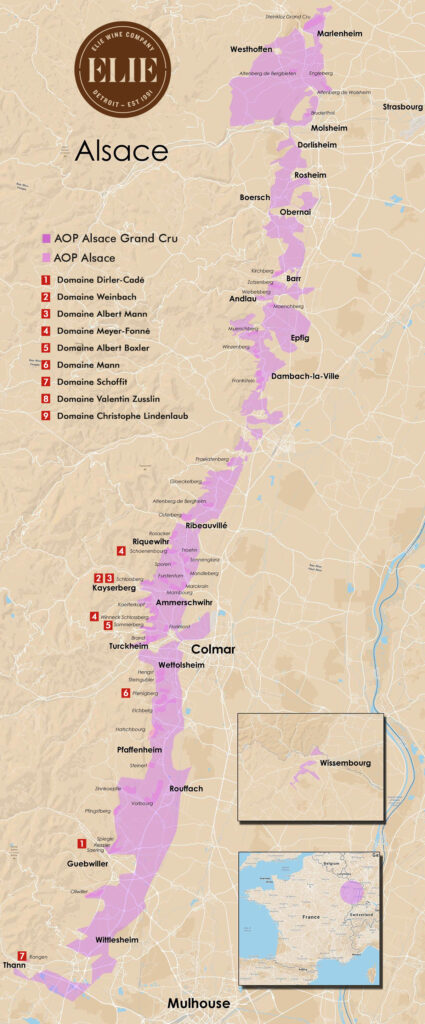
Riesling: The Most Transparent of Grapes
The diversity of Alsace terroirs is ideal for this grape as it’s a transparent veil. Transparency, like minerality (and many other things ‘Riesling’) is often misunderstood. Essentially, it refers to a wine’s ability to translate the specifics of its vineyard site into flavors, aromas and textures that present themselves in the glass. Riesling is particularly adept at this, and the result is a flavor profile with an almost infinite variety of expressions.
Of course, this not a grape that suffers fools with foolish vineyard sites gladly. In order to give up this characteristic transparency, Riesling requires cool climate conditions, and in excessive heat, it quickly over-ripens and becomes flabby. Given long, slow ripening, however, Riesling’s power is without parallel. It’s no surprise that some of the world’s finest examples come from cold regions, where the vines are grown on terraces on steep slopes that maximize exposure to the sun. Some of the world’s top Riesling locations demonstrate marginal viticulture that walks a fine line toward greatness. Riesling, a grape that is often associated with struggle, thrives best in rocky, barren sites, but the reward of that struggle is the variety’s amazing ability to convey the signature of that site.
Alsace: A Geologist’s Dream
An Alsace cliché: ‘Walk 100 feet in any direction and you’ll find a totally different soil composition.’
The terroir of Alsace is, in fact, a mosaic of diversity; soils underlying the vineyards are a tapestry ranging from the schist and granite of the higher elevations (extending into the Vosges Mountains) to the limestone and chalk of the lower slopes and to the clay and gravel of the valley floors. However, it is the unique, reddish-colored sandstone of Alsace—known as grès des Vosges—that may be most interesting. Vosges sandstone runs in a large, horizontal swath through the range just below the granite layer from which it is derived and atop a layer of coal. Grès des Vosges is hard, compact sandstone composed mainly of quartz and feldspar. Its pink-reddish color is due to the presence of decomposing iron (iron oxide, as also seen in red soils throughout the world) that occurred as a result of the slow cooling of large masses of magma as it hardened into granite.
Most of the wine-making villages in Alsace are built on four or five different formations in a juxtaposition of often-restrained parcels, providing a montage of uniquely abundant and diverse soils. These infinite variations are the very heart of the exceptional diversity found in the Vins d’Alsace.
Grand Cru: Singularity of Character, Diversity of Climats.
As a gold medal represents the highest award that an Olympic athlete can win, in the wine world, Grand Cru is the highest designation to which a plot of land can aspire. If you are a lover of French wine (a rhetorical point since you are reading these words), it is no doubt a term that is both mysterious and sacred, as various pieces of earth have been considered in religious tradition from time immemorial; Kashi Viswanathan in India, Mecca in Arabia and Lourdes in France. Although not imbued with supernatural powers of healing, Grand Cru vineyards are saturated in terroir that is considered the ne plus ultra of any wider appellation.
At least, that’s the theory. In our continued exploration of Alsace, we find that Grand Cru status has an additional determining factor: Politics. This is not to suggest that these are not the finest wines that Alsace can produce, only that it may not be a guarantee of it, at least compared to Burgundy. Alsace has enormous geological diversity within a fairly constrained area, and each Grand Cru may rightly claim its own unique identity rather than an absolute commitment to rules that would ensure top quality and singularity of character.
Domaine Dirler-Cadé
As the name suggests, Domaine Dirler-Cadé is the union of two historical Alsatian winegrowing families. Jean Dirler is a 5th generation winemaker whose family had been making wine in the tiny village of Bergholtz, tucked into the lower hills of the Vosge Mountains, since 1871. Ludvine Cadé’s family owned vineyards in nearby Guebwiller, known as Domaine Hell-Cadé. The marriage of Ludvine and Jean in 2000 produced Domaine Dirler-Cadé, one of the finest domains in Alsace, with almost half of their 44 acres in Grand Cru vineyards, as well as plots in five lieux-dits.
A century before natural winemaking was in vogue, Jean’s family had been practicing winemaking under the motto ‘natural wines, fine wines.’ But during a training course with François Bouchet in 1997, Jean and his father Jean Pierre became convinced that biodynamics is the best possible way to produce true terroir wines.
Jean explains the eureka moment: “Right after the Bouchet course, we began to cultivate organically and biodynamically in order to best express the exceptional personality of these terroirs. In many parcels, we plough partially in autumn and completely in spring to ensure th destruction of the superficial roots and then let natural grassing reconstitute in summer to create a balanced and vita ecosystem.”
Jean-Pierre adds, “The soil in the vineyards is plowed four to five times a year by horse. The team removes flowers versus green harvesting, and old canes are not pruned off until March. Other organic practices such as natural crop covers, herbal teas, and homeopathic doses of horsetail instead of fertilizers. It doesn’t stop there—at harvest time, a small, close group of vineyard workers share food and wine during the season, as it is important to harvest the fruit by hand in a joyful and good mood, with a positive energy.”
In the winery, Dirler-Cadé uses slow, whole-cluster presses, spontaneous fermentations, and prolonged maturation on the lees. The resulting wines are expressive and complex, with a versatility that makes them just as fitting at a three-star Michelin restaurant as they are at a natural wine fair.
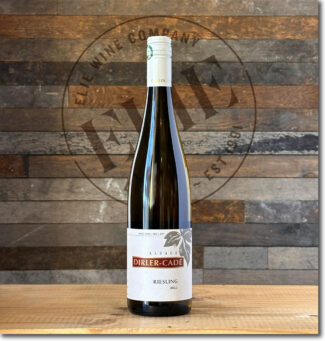 Domaine Dirler-Cadé, 2022 Alsace Riesling ($32)
Domaine Dirler-Cadé, 2022 Alsace Riesling ($32)
Built from declassified Grand Cru grapes, Dirler-Cadé’s basic Riesling retains many of the markers of their vineyards of origin, juicy, supple, and aromatic, with intricacies of lime, verbena, herbs, and spice.
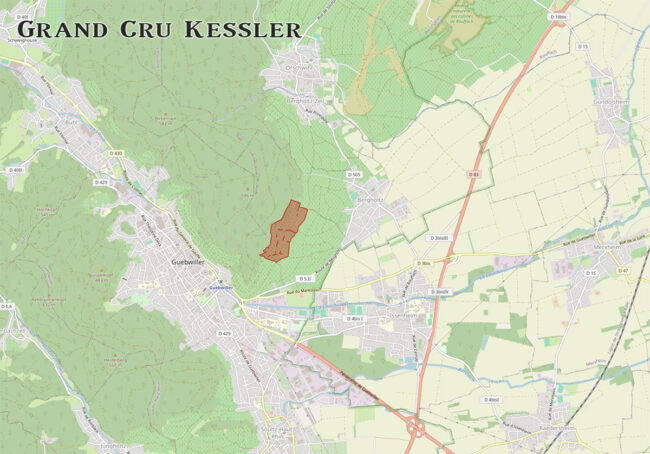
Grand Cru Kessler: “Exceptional Minerality Issued From Rich Sandstone Soil.”
Kessler Grand Cru is not only shaped like a basin, ‘basin’ is what Kessler means. The site is sheltered from the cold winds blowing along the Guebwiller valley, where dry stones form an unmistakable tie between the neighboring Grand Crus of Saering, Spiegel and Kitterlé. The blend of sand with heavier scree and its steep slope stimulate the production of wines full of character.
Kessler sits on a sandstone substrate from the Buntsandstein Vosges area, where erosion has produced red soils with rather abundant mineral deposits. At its base there is a linear outcrop of Muschelkalk limestone covered by sandstone. This creates compact and erythemal soils with a scant water table. But vineyards thrive only by developing a very deep root-growing system.
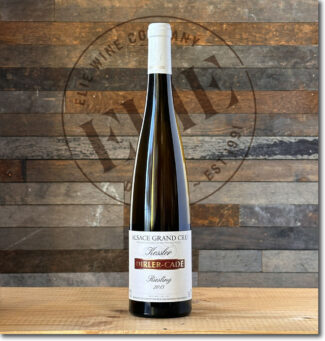 Domaine Dirler-Cadé, 2013 Alsace Grand Cru Kessler ‘Heisse Wanne’ Riesling ($45)
Domaine Dirler-Cadé, 2013 Alsace Grand Cru Kessler ‘Heisse Wanne’ Riesling ($45)
As the estate’s flagship wine, the iconic Heisse-Wanne bottling is from 80-year-old, southwest-facing vines grown on steep terraces at the upper limits of the Kessler, where plowing must be done by horse. Always notably richer than standard Kessler, it is striking for the intensity of the mineral extract and the concentration of Riesling fruit; peach, green apple and lemon peel.
Domaine Weinbach
Named after the little stream which runs through the property, Domaine Weinbach was first planted with vines in the 9th century and established as a winery by Capuchin friars in 1612. After being sold as a national property during the French Revolution, it was acquired by the Faller brothers in 1898, who then left it to their son and nephew, Théo Faller. Following his death in 1979, his wife Colette and daughters Catherine and Laurence continued the family’s passion for great wines until the untimely deaths of Colette and Laurence. Since 2016, Catherine has led the estate winery with her sons, Eddy and Théo.
Domaine Weinbach owns 65 acres of vineyards in the Kaysersberg valley in the Haut-Rhin of Alsace at between 600 and 1300 feet above sea level. Vines are grown organically with a view to quality rather than quantity and grapes. Unlike most producers in Alsace, who purchase from négociants, Weinbach vinifies only estate grown grapes, and their aging philosophy is best described as passive, carried out in huge old oak foudres, a technique they believe allows each climat and each terroir (along with the other unique characteristics of grape and vintage) to shimmer through and produce elegant and sophisticated wines.
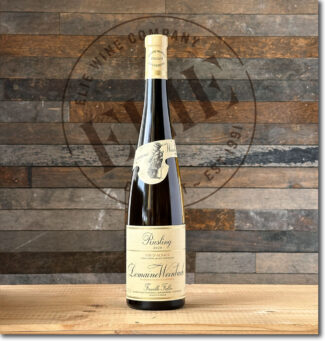 Domaine Weinbach, 2020 Alsace Riesling ($35)
Domaine Weinbach, 2020 Alsace Riesling ($35)
Pineapple and ginger on the nose, with grapefruit, peach, pear and cut grass appearing mid-palate along with notes of honeycomb.
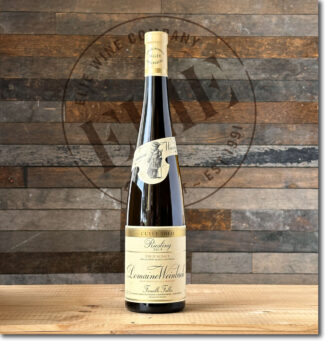 Domaine Weinbach ‘Cuvée Théo’, 2019 Alsace Riesling ($39)
Domaine Weinbach ‘Cuvée Théo’, 2019 Alsace Riesling ($39)
Harvested in the granitic sand of the monopole Clos des Capucins, the 2019 ‘Cuvée Théo’ displays a slightly flinty nose and classic Riesling intensity with lychee and mangosteen, lime and crisp Granny Smith apples.
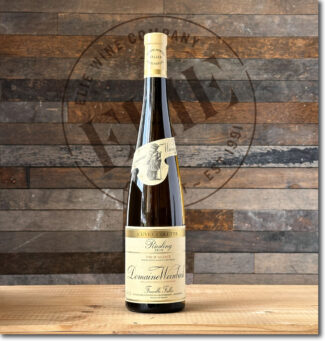 Domaine Weinbach ‘Cuvée Colette’ 2019 Alsace Riesling ($54)
Domaine Weinbach ‘Cuvée Colette’ 2019 Alsace Riesling ($54)
Cuvée Colette comes from a portion of Schlossberg not entitled to Grand Cru status, but has many of the characteristics that elevate the vineyards in this part of Alsace, resulting in a silken, pure and refined wine, fresh with wet stone and the bright bouquet of white peach and lemon, finishing with a spark of salinity.
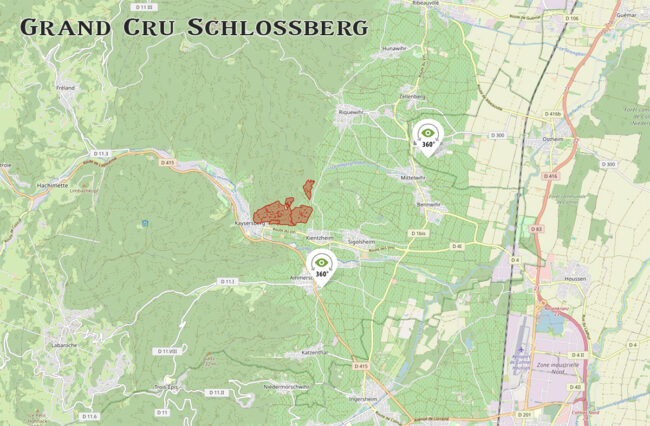
Grand Cru Schlossberg: “Graceful and Floral, Freshness Drawn From Granite Soil.”
About five miles from Colmar, Schlossberg overlooks the Weiss valley from the outskirts of the town of Kientzheim up to the medieval Kaysersberg castle. The 150-acre Grand Cru sits on very steep hillside. The lieux-dits, therefore, are covered by a succession of terraces between 750 and 1300 feet in altitude, with the majority facing due south on the Bixkoepfel hillside, with a small detached portion looking towards the east.
Schlossberg is solidly Riesling country, with coarse and sandy-clay soil creating a rich surface with a wide diversity of mineral components like potassium, magnesium, fluorine or phosphorus. Combined with low water retention, this is the sort of high-altitude neighborhood in which Riesling can likewise reach great heights.
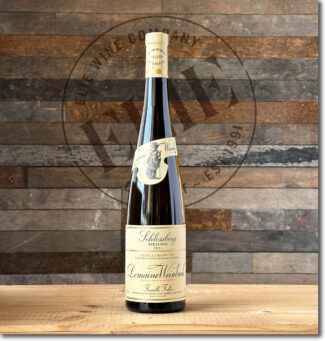 Domaine Weinbach, 2021 Alsace Grand Cru Schlossberg Riesling ($99)
Domaine Weinbach, 2021 Alsace Grand Cru Schlossberg Riesling ($99)
Wild herb and dried citrus zest drive a sensationally crisp wine with hints of mandarin orange, persimmon, jasmine and chamomile. The fruit is ripe and the acidity is vibrant, leading to an intense, long finish flecked with salty minerality.
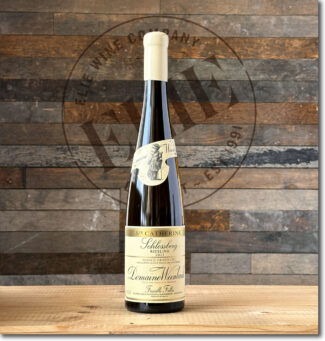 2021 Domaine Weinbach ‘Cuvée Ste Catherine’ Alsace Grand Cru Schlossberg Riesling ($135)
2021 Domaine Weinbach ‘Cuvée Ste Catherine’ Alsace Grand Cru Schlossberg Riesling ($135)
From 60-70-year old vines on the mid-slope of Schlossberg. It was fermented over a full year and stopped at around 5 grams/liter of residual sweetness—rich for the domaine, but with sufficient acidity to carry it off. The nose is ripe with orange blossom and pineapple; the palate shows a bit of smoky reduction framed by the crystallinity of the granitic terroir.
Domaine Albert Mann
According to David Schildknecht of The Wine Advocate, “The Barthelmé brothers, Jacky and Maurice, have maintained their position near the forefront of Alsace viticulture by farming a range of relatively far-flung and outstanding vineyards as well as offering excellent value virtually throughout their range.”
The fifty acres for which the Barthelmé are responsible are highly regarded throughout Alsace. Headquartered in the village of Wettolsheim near Colmar, the spirit animal of the operation is Albert Mann, Maurice’s father-in-law. He was the first to hit upon the idea of using modern production tools without neglecting the constraints of the land and his philosophy was to make wine using the elements of the soil, without the help of fertilizers. The Barthelmé brothers have embraced his beliefs and are now at the forefront of organic/biodynamic Alsace producers. The goal of the estate is to produce wine that is in harmony with nature: “Wine is the memory of the grape and is capable of transmitting the taste of the earth.’
The brothers began practicing biodynamic viticulture in 1997 in three of their Grand Cru vineyards, receiving certification from Biodyvin in 2015. This labor-intensive technique is intended to give the wine the purest reflection of its terroir and own identity. Says Maurice, “In ploughing the vineyards, we encourage the roots to descend to a maximum depth to capture the beneficial mineral elements from degraded rock below. Our holdings are divided up into a myriad of distinct plots, thus ensuring that each wine is reflective of their precise origins, while remaining as complex and multi-faceted as possible.”
The domain owns vines in five separate Grand Cru sites.
 Domaine Albert Mann, 2020 Alsace Riesling ($30)
Domaine Albert Mann, 2020 Alsace Riesling ($30)
An entry-level Albert Mann by name alone: This 100% Riesling is exhuberant with Mandarin orange, Meyer lemon, Angostura bitters and a firm backbone of minerality.
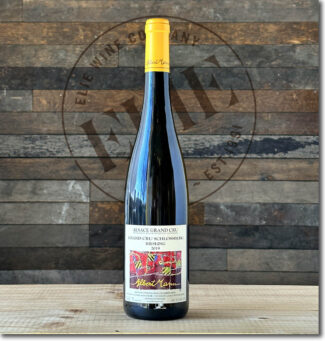 2019 Domaine Albert Mann Alsace Grand Cru Schlossberg Riesling ($88)
2019 Domaine Albert Mann Alsace Grand Cru Schlossberg Riesling ($88)
A substantial, acid-ripped Riesling that, while exuding youth, is built for the ages. The nose is marked by hawthorn and lime blossom, while on the palate, citrus peel is underlined by a minerality that beautifully expresses the granitic terroir.
Domaine Meyer-Fonné
Félix Meyer is one of those winemakers whom you sense is a star that will grow ever brighter with every vintage. He is the third generation in his family to be making wine since his grandfather founded Meyer-Fonné in the late 19th century and since taking over 1992, Félix has modernized equipment, developed export sales and is currently driving the family’s holdings deeply into the best vineyards of Alsace.
According to Félix, “Our vineyard covers eighteen hectares and seven communes, where the nature of the soils, the relief of the land and levels of exposure are varied. The soils range from poor quality filtering alluvial deposits (Colmar) to rich, deep clayey sandstone land in Riquewihr, with granite in between in Katzenthal, while the relief ranges from the flats of Colmar to the steeply sloping Katzenthal. The degrees of exposure are also very varied, ranging from the cooler western part which is suitable for the earlier vine types to the south-facing part which is very warm and sunny. This great variety of terroirs constitutes a distinctiveness and a richness in relation to many of the French vineyards.”
A stickler for detail with an overriding sense of responsibility, both his family and the earth, he makes his home in Katzenthal, known for its distinctive granite soils. With this remarkable terroir beneath his feet, Meyer has developed a knack for mixing wine from various of his parcels into complex and balanced cuvées. Among his cellar tricks is leaving wine to age on lees in large, older foudres, as was once the tradition in Alsace. All of Meyer’s bottlings are characterized by their stunning aromatics and signature backbone of minerality and electric acidity.
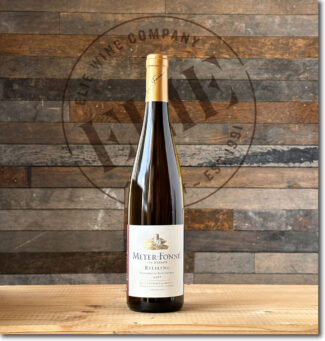 Domaine Meyer-Fonné ‘Vignoble de Katzenthal’, 2017 Alsace Riesling ($27)
Domaine Meyer-Fonné ‘Vignoble de Katzenthal’, 2017 Alsace Riesling ($27)
From the granite slopes surrounding the Meyer family’s property in Katzenthal, this wine is a blend of grapes planted in 1985 and 2009 in granitic soil with mica and calcareous marl. It is deep, spicy and resinous, and might easily be confused for a Cru wine from the region.
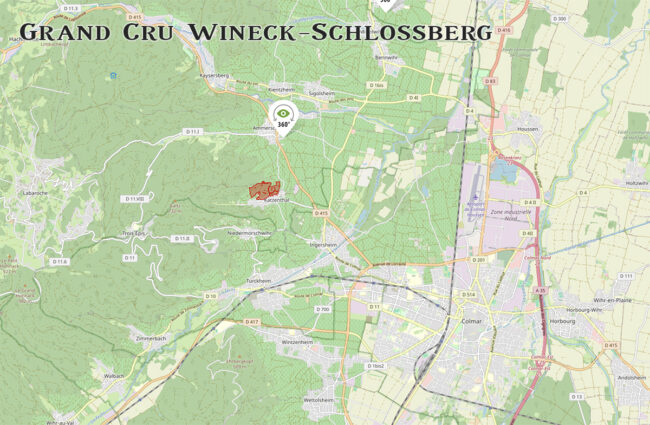
Grand Cru Wineck-Schlossberg: “Fine with Crystalline Structure. Demarcates Between Minerality and Salinity.”
Located in an amphitheater open exclusively to the south, Wineck-Schlossberg is a smallish Grand Cru (67 acres), wonderfully protected from the wind by three hills. The parcels are delimited so that each one of them benefits most favorably from the microclimate; the steep slope is mostly exposed due south with south-east and south-west variations along the small valleys surrounding the Wineck Castle, the feudal ruins that sits in the middle of the vineyard.
The soil is composed of two-mica granite from Turckheim, very weathered, deep ‘grus’—granite weathered down to individual minerals; subsoil belongs to the crystalline-base foundation of the Vosges mountain range.
Riesling does extremely well on these slopes and ripens early here. And why not? It adores granite and likes pebbly and light soils; its rooting system easily ventures deeply into the grus, and can be found from the summit to the mid-slope of the hills.
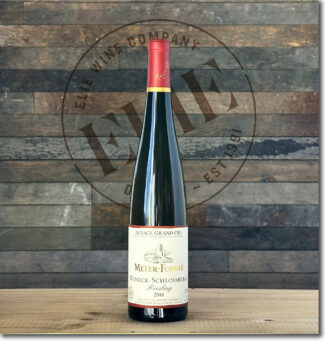 Domaine Meyer-Fonné, 2016 Alsace Grand Cru Wineck-Schlossberg Riesling ($45)
Domaine Meyer-Fonné, 2016 Alsace Grand Cru Wineck-Schlossberg Riesling ($45)
The crumbly binary mica granite known as ‘de Turckheim’ in the Wineck-Schlossberg Grand Cru gives this wine a pure and delicate with (as suits the winemaker’s name) Meyer lemon and fresh tarragon lacing white peach, grated ginger, lemon curd and stone notes.
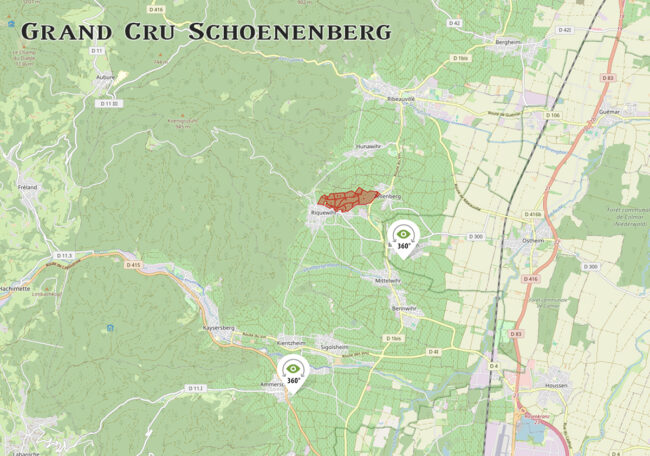
Grand Cru Schoenenberg: “Intense Sensation, Which Precedes a Minerality Evoking Warm Pebbles.”
Voltaire owned several acres. The great Swiss mapmaker Merian, mentions it in 1663: “Schoenenbourg is where the most noble wine of this country is produced …”
The locality, with a surface area of 130 acres, sits on terrains of Keuper marl, dolomite rock and gypsum, rich in fertilizing elements which have good water retention. They are covered with fine Quaternary-period layers of Vosges and Muschelkalk sandstone silt-pebbles, resulting in structured, full-bodied wines backed by robust exuberance, with gypsum expressed in smoky, match-stick and flint notes.
Schoenenbourg Grand Cru wines age wonderfully, developing intense and rich aromas. The terroir microclimate is particularly suited for the prestigious Vendanges Tardives and Sélections de Grains Nobles. Schoenenbourg requires patience, and it’s really only after aging for five to seven years that it fully expresses its potential, although it is easily able to preserve it’s mature splendor for years afterward.
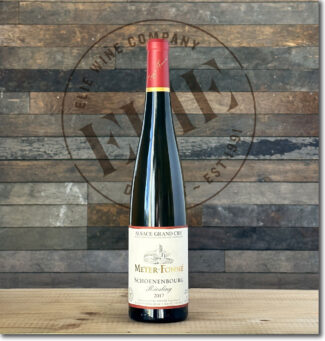 Domaine Meyer-Fonné, 2017 Alsace Grand Cru Schoenenberg Riesling ($45)
Domaine Meyer-Fonné, 2017 Alsace Grand Cru Schoenenberg Riesling ($45)
Only ten cases of Meyer-Fonné Schoenenbourg are imported into the United States every year, so consider the availability a remarkable opportunity. Much like the clay and ‘marne verte de keuper’ marl terroir itself, this wine is weighty stuff. Grapes were gently pressed in a pneumatic press for 4-10 hours, then the must was left for 24-36 hours to allow the heavy lees to settle. It was fermented over three months in temperature-controlled stainless steel tanks (with limited use of oak barrels), racked two weeks after fermentation has completed and kept on the fine lees until a September bottling. It is a precise, dry, mineral-focused Riesling combining ripe apple flavors with bright citrus and shows subtle chalk on the finish.
Domaine Albert Boxler
The list of storybook names in Alsace does not always include Domaine Albert Boxler (who produces a scant 5200 cases of wine per year) but it should; there are few serious critics who would take exception to the statement that Jean Boxler, Albert Boxler’s grandson, is responsible for producing some of the most complex and terroir-driven white wines not only in Alsace, but in the world. In an equal blend of nature and nurture, Boxler’s portfolio contains a remarkable roster of racy, intensely structured and very long-lived wines.
The Boxler family’s 32-acre holding is centered around the ancient village of Niedermorschwihr in the Haut-Rhin, dominated by the imposing granite hillside Grand Cru, Sommerberg. “At the conclusion of World War II, my grandfather Albert returned to Niedermorschwihr from Montana, where he had been busy enjoying the natural gifts of Big Sky country.” Jean says. “He was in time to harvest the 1946 crop. He became the first generation to bottle the family’s production himself and commercialize it under a family label—in fact, the wine still wears a label drawn by our cousin. My father Jean-Marc continued the tradition for several decades until passing the baton to me in 1996.”
Jean vinifies micro-parcels separately, de-classifying some into his Réserve wines and producing multiple bottlings of Sommerberg from the different lieux-dits depending on the vintage. Sommerberg Riesling, Pinot Gris and Pinot Blanc are the specialties of the domain, while Boxler also produces one of Alsace’s best Crémants (and Edelzwicker), an incredible Gewürztraminer grown in limestone, and some of the most hauntingly pure Vendanges Tardives and SGNs in all of Alsace. If that weren’t enough, the Boxlers also own land in the powerful Grand Cru Brand, the ultimate counterpart to their holdings in Sommerberg.
“The Sommerberg hillside terminates in my driveway,” Jean laughs, “making it easy to basically live in the vineyards and ensure exceptionally healthy fruit year after year. After harvest, our wines are vinified and aged in old foudres in a small cellar underneath the family home until bottling. Not much has changed over the centuries because not much has needed to.”
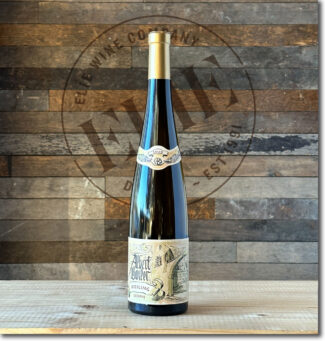 Domaine Albert Boxler ‘Réserve’, 2020 Alsace Riesling ($73)
Domaine Albert Boxler ‘Réserve’, 2020 Alsace Riesling ($73)
Sourced from the Dudenstein lieu-dit within Sommerberg (because the other two parcels normally added to the Réserve were too low in acidity), the 2020 Riesling Réserve is bright and aromatic with ripe peach and mango intertwined with soft smoke. Slightly piquant in the style of the best Alsace Rieslings, the finish is structured and dense, yet maintains its signature cleanliness on the palate.
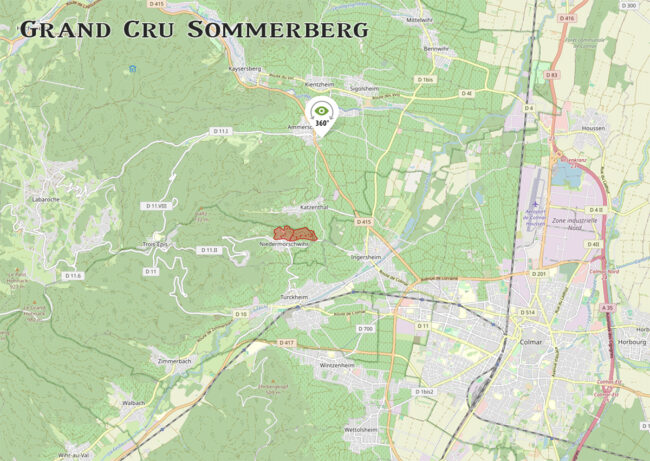
Grand Cru Sommerberg: “Delicate Freshness, Which Evolves Toward Roasted and Exotic Notes.”
Sommerberg stretches over the foot of the Trois-Épis mountain to the south of Katzenthal and to the north of Niedermorschwihr. Located on a 45° angle hill oriented directly to the south, Sommerberg covers 69 acres overlooking Niedermorschwihr. The slopes rise steadily to 1310 ft. and so are amongst the steepest in Alsace, rivaling even the severity of the volcanic hillside of the Rangen Grand Cru.
The Sommerberg hillside is composed of mica-rich granite with the upper layers in an advanced state of decomposition. As a result, the topsoils contain a high proportion of granitic sand, rich in minerals not found in most other Alsace vineyards. It also receives only about 21 inches of rain a year, making it among the driest sites in the northern half of Frane.
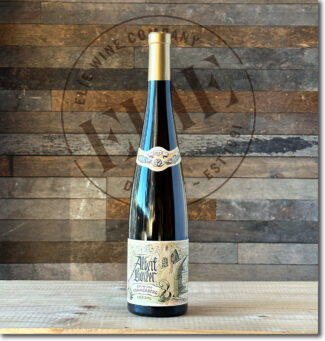 Domaine Albert Boxler, 2020 Alsace Grand Cru Sommerberg Riesling ($99)
Domaine Albert Boxler, 2020 Alsace Grand Cru Sommerberg Riesling ($99)
The granitic soils of Sommerberg are further shaped within the wine by allowing the élevage time to develop in well-seasoned foudres. The wine, with the potential to become even better over the years, shows perfectly ripe fruit rife with the beautifully flinty and herbal terroir notes of the super-steep vineyard.
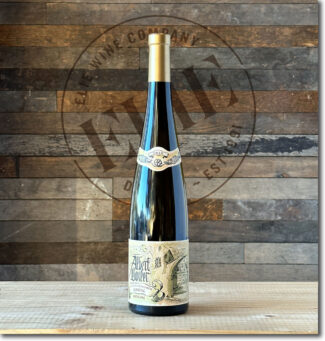 Domaine Albert Boxler, 2020 Alsace Grand Cru Sommerberg ‘Eckberg’ Riesling ($117)
Domaine Albert Boxler, 2020 Alsace Grand Cru Sommerberg ‘Eckberg’ Riesling ($117)
From 45-year-old vines in a steep mid-slope lieu-dit in the geographic center of the Sommerberg, the Eckberg parcel is vinified separately by Boxler only in exceptional years; 2020 certainly qualifies. The wine boasts vivacious acidity combined with saline undertones that set off apricot, citrus, wet rock, honeycomb and freshly-cut jasmine.
Domaine Mann
After stints in Côte-Rôtie and Champagne, where he learned the value of biodynamics from Bertrand Gautherot, Sébastien Mann has been making wine at the family estate since 2009, taking over from his father. He says, “I think that thanks to biodynamics, we have succeeded in bringing an additional element to our vines. My father made wines essentially linked to the earth; I have a much more holistic style, linked to the stars.”
Domaine Mann’s 32 acres were founded upon the theory that in order to produce terroir-driven wines with aging potential, legally allowable yields have to be cut in half. From the outset, the estate produced 35 cuvées, one for each parcel.
“The style of the wines changed very quickly when I came on board,” Sébastien maintains. “95% of the wines we produce now are dry. It was not an easy task, since Alsace is one of the warmest and driest regions in France. Grapes can easily ripen with a high sugar level. I don’t think my father could imagine that with biodynamics we would be able to achieve such a great evolution, achieving phenolic maturity while making dry wines.”
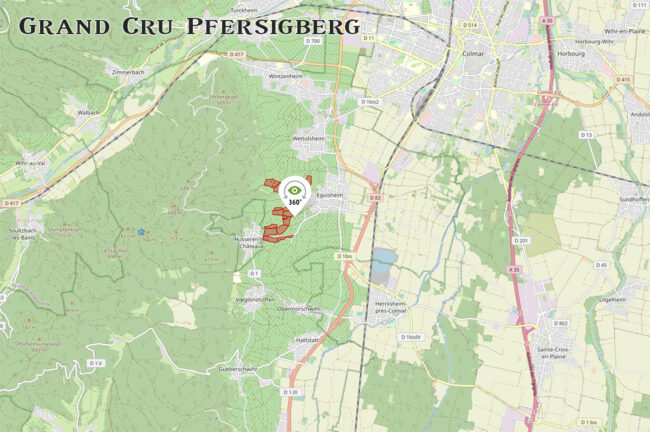
Grand Cru Pfersigberg: “Sensation of Density Without Loosing Minerality .”
Straddling the communes of Eguisheim and Wettolsheim, Pfersigberg is one of four Grand Crus which run in a line just to the south-west of Colmar. The third-largest Alsace Grand Cru, at 184 acres, it also is a land of gentle slopes, unlike the nearly unmanageable vineyards of Zinnkoepfle and Rangen.
Pfersigberg soils are predominantly composed of limestone and marlstone, with a higher quantity of clay than is usual this far away from the river basin. This clay reduces the drainage efficiency of the local soils. The Cru is noted for the concentration of Gewürztraminer, although Pfersigberg wines may also be produced from Riesling, Pinot Gris or Muscat.
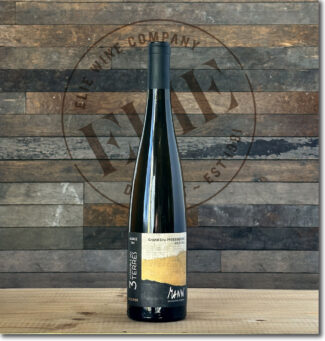 Domaine Mann, 2018 Alsace Riesling Grand Cru Pfersigberg ($69)
Domaine Mann, 2018 Alsace Riesling Grand Cru Pfersigberg ($69)
A near perfect representation of Alsace Grand Cru Riesling with a number of years under its belt showing the evolution of tertiary flavors (honey, beeswax and petroleum) while retaining gentle reminders of the freshness of youth—pear, plum, white peach, infused with gentle notes of chamomile.
Domaine Schoffit
To call a man a ‘pioneer’ who cultivates wine country that has been famous for eight hundred years (vintage 1228 was described as ‘extremely good; so hot you could fry an egg in the sand’) may seem a stretch, but the spirit that impelled Bernard Schoffit to purchase 16 acres around Clos St. Théobold belongs to a frontiersman. Previously abandoned because the slopes were deemed too steep to work, the vines in question (in Rangen de Thann AOP) grew on a plot of soil that has been likened to Montrachet and Chambertin. And from this forbidding site, relying on extremely low yields, he is making extraordinary wine with each cépage.
In addition, Schoffit raises grapes in the lieu-dit Harth, an alluvial terroir close to the commercial area of Hussen in northern Colmar, and three acres in the granitic Grand Cru Sommerberg to the south of Katzenthal and to the north of Niedermorschwihr. In Harth, Schoffit tends 80 years old Chasselas vines, of which a few percent are replanted each year as an illustration of Schoffit’s long-term perspective.
Based near Colmar, Bernard took the winery over from his father Robert and his son Alexandre is now a co-owner. Demonstrating the estate’s commitment to sustainable agriculture Alexandre maintains, “All our vineyards are organic, and we also started to work biodynamic a few years ago. In order to show more transparency, I decided in 2016 to launch the official certification process, but for administrative reasons it was stretched over different years. The first wines officially labeled fully organic will be some cuvées of the 2019 vintage (Harth Riesling and Harth Pinot Gris for example), and the rest of the classic range will follow in the 2020 vintage. For the Grand Crus, it will be from the 2022 vintage. The official certification for biodynamic is in progress and we are still waiting to know from when we will be able to use it on the labels. But for now, Domaine Schoffit gives the assurance that we are both bio and biodynamic!”
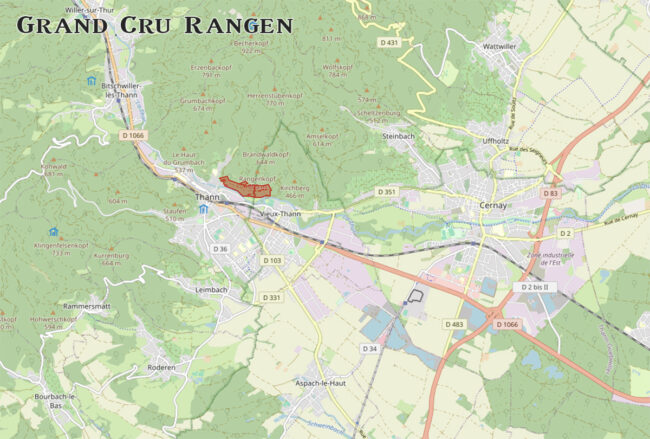
Grand Cru Rangen: “Mineralized Volcanic Soils Produce Aromas Marked by Smokiness.”
Volcanic upheaval is the name of the game at inconspicuous hillside adjacent to the town of Thann, making it a geological anomaly in the Vosges Mountains. But there even more bang for that buck—while ploughing Rangen acres that had been abandoned for multiple generations, Olivier Humbrecht (Domaine Zind-Humbrecht) uncovered three unexploded bombs from World War II. Dotting the eastern slopes of the Vosges Mountains and is notable for more than just its terroir: Rangen is the only site in Alsace to be classified as Grand Cru in its entirety, and is home to the highly respected Clos Saint Urbain and Clos Saint Théobald vineyards.
In Rangen, the altitude climbs higher (1100 to 1525 feet) and the slopes have an average gradient of 60%. It is predominantly planted to Pinot Gris, the variety that accounts for 57% of vines; Riesling represents about a third of the site while Gewürztraminer is 10%. Despite its southerly aspect, Rangen is late-ripening, mainly due to its higher rainfall and cool winds which also make the site more prone to botrytis and its attendant Sélection de Grains Nobles and/or Vendanges Tardives sweet wines.
The late-ripening terroir also increases power (and often alcohol) in the wines. Wines from Rangen are often described as having a ‘smoky’ taste.
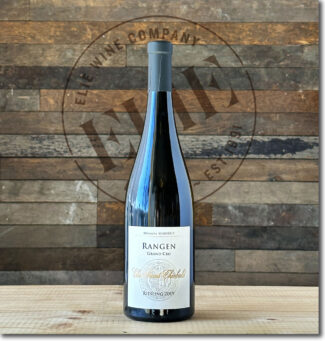 Domaine Schoffit, 2019 Alsace Grand Cru Rangen ‘Clos Saint-Théobald’ Riesling ($60)
Domaine Schoffit, 2019 Alsace Grand Cru Rangen ‘Clos Saint-Théobald’ Riesling ($60)
Clos Saint-Théobald sits to the east of Clos Saint Urbain and is, like Urbain, a monopole owned entirely by Domaine Schoffit. One wine pro described it this way: “The vineyards of Clos Saint-Théobald are aggressively steep and the footing is treacherous with loose rocks and dry, sandy soils slide constantly, threatening to send you tumbling down the hillside. The Schoffits will warn you: If you fall, don’t damage the grapes.”
The wine shows the bite of fresh pineapple with smoke and floral notes. But it is the minerality that stands out and gives the wine an intensely salty finale.
Domaine Valentin Zusslin
Aligned with the same winemaking traditions it first established in 1691, Zusslin is located in the southern part of Alsace in Orschwir on the Bollenberg, Clos Liebenberg (a Zusslin monopole) and the hillsides of Pfingstberg Grand Cru.
Early to the Crémant game, the domain was also an early practitioner of biodynamics, having introduced this philosophy to viticulture in 1997. Says Valentin (whose name, perhaps, makes this an iconic sparkling wine for February 14): “We plant cover crops to encourage good insects and microbial life for the soil, encourage bees to pollinate the beneficial plants and we grow trees to attract the birds that eat the harmful bugs. This way of thinking carries through everything we do in the fields and in the winery.”
In addition, his wife Marie insists that their lifestyle goes far beyond a philosophy, and as evidence, she indicates the wall on the property that bears names of 13 generations of Zusslin winegrowers: “We represent not only history, but the circle of life.”
‘Lieu-dit’ Identity: Geographical Detail
As in Burgundy and the Rhône Valley, an Alsatian lieu-dit is a specific part of a vineyard or region recognized for a unique topographic or historical specificity. They are often a smaller part of a named Climat, and are generally used as a microscope that accentuates a particular quality. When you see a lieu-dit mentioned on a wine label (and can distinguish it from a proprietary winemaker name for the bottling), it has genuine meaning.
However, unlike Burgundy and the Rhône Valley, in Alsace Grand Cru AOPs, the listing of the lieu-dit is mandatory and the Grand Cru designation may be used only if a lieu-dit is also indicated. (Lieux-dits may also be indicated on regular Alsace AOP wines, but is not mandatory.)
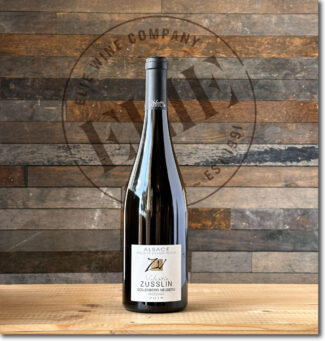 Domaine Valentin Zusslin, 2018 Alsace ‘Bollenberg Neuberg’ Riesling ($51)
Domaine Valentin Zusslin, 2018 Alsace ‘Bollenberg Neuberg’ Riesling ($51)
Bollenberg is one such lieu-dit. Located on a hill near Rouffach and the Domaine Valentin Zusslin’s home village of Orschwir, it’s one of the driest places in France with only about 15 inches of annual rainfall. The vineyard sits on 23 million year old limestone, lending a salty base to the wines produced here. 2018 Riesling is a complex and evolving example of the Zusslin’s imperative of terroir-reflection. It shows star-anise, lemongrass, and emerging notes of butter and honey.
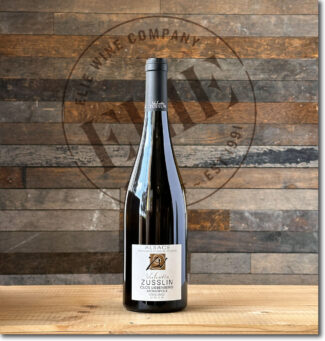 Domaine Valentin Zusslin, 2016 Alsace ‘Clos Liebenberg’ Monopole Riesling ($51)
Domaine Valentin Zusslin, 2016 Alsace ‘Clos Liebenberg’ Monopole Riesling ($51)
Clos Liebenberg represents a group of plots of almost ten acres atop the Pfingstberg hill. A Zusslin monopole, Clos Liebenberg is a southeast-facing vineyard surrounded by wild hedges, stone walls and forest, the highest property owned by the winery. Surrounding forest helps to retain moisture and keeps temperatures lower than nearby terroirs. Clos Liebenberg wines display a tension and a elegance typical of cool sandstone terroirs; the 2016 is, at this point, wonderfully mature with intense iodine and chalk, a slightly reductive nose that expresses Mirabelle peach and quince, with a long saline finish.
Domaine Christophe Lindenlaub
It’s no surprise that Christophe Lindenlaub has gone the winemaking route: His family has been growing grapes in the northern Alsace town of Dorlisheim for over 200 years. But he brings a slightly new approach to the sorting table: Over the past decade, he has worked diligently to convert the family’s 30 acres into organic viticulture and the cellar to the production of zero-additive wines.
“Our vineyards consist mainly of clay and limestone soil, some with a sandstone sub-layer, with vines mostly aged between 30 and 60 years,” Christophe explains. “My focus has been to harness the true potential of our sites by moving away from chemical intervention in the vineyard and cellar, and I use primarily stainless steel for élevage as a means to further define the freshness and precision in the wines.”
 Christophe Lindenlaub ‘En Équilibre’, 2021 Alsace Riesling ($35)
Christophe Lindenlaub ‘En Équilibre’, 2021 Alsace Riesling ($35)
100% Riesling from vines grown at 700 feet in a south/southeast-facing vineyard. The grapes are hand-harvested, cold soaked and direct-pressed into stainless steel tanks, then aged sur-lie for eight months in stainless steel. It is bottled without sulfur, and without fining or filtration, giving it a smoky richness.
The wine shows a clean spine of acidity highlighted by flavors of green apple, Anjou pears, lemon peel and green tea, brightened by a hint of petrol.
Clime and Riesling: Mountainous Northern Catalunya Makes The Grape Its Own
At first pass, Spain and Riesling may seem like unlikely bedfellows; under the tyranny of a warming planet, Spain has undergone a series of recent, record-breaking heat waves, with temperatures into triple digits by May—green kryptonite to a variety that thrives best in the cool summers of northern Europe.
Elevation is proving to be the saving grace, and the most delicious irony in changing weather patterns is that regions once considered too cold for vines are warming to the point that they can produce quality wines. In Catalunya, vineyards at the foothills of the Pyrenees are being planted at altitudes up to 4,000 feet. Twenty-five years ago, this would have been impossible, but formerly inhospitable areas are beginning to slip into vineyard Goldilocks Zones.
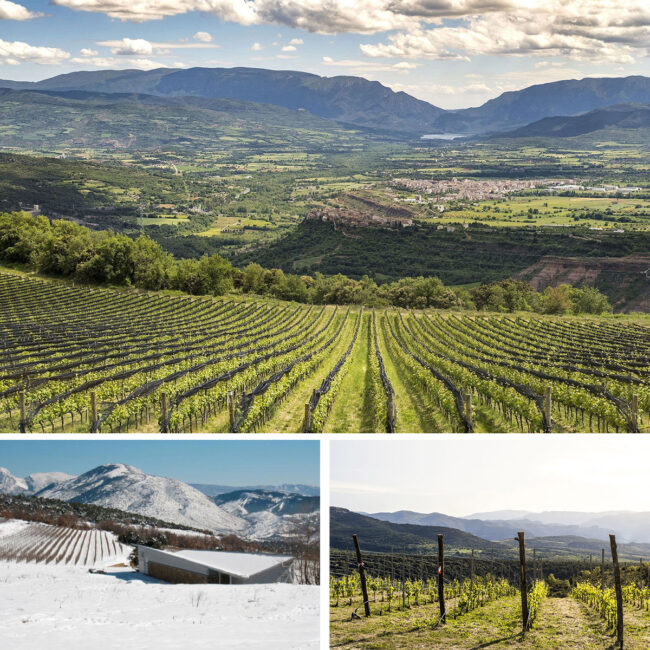
Castell d’Encus, Talarn, Lleida
At higher elevations, peak temperatures are not necessarily much cooler, but intense heat lasts for shorter periods and nighttime temperatures are colder than at lower altitudes. This increased diurnal shift (the temperature swing over the course of a day) helps grapes to ripen at a more even pace, over a longer period of time, than where temperatures remain relatively stable.
Pushing altitudes creates a unique set of challenges, of course: Soils, particularly on slopes, are generally poorer, water is scarcer and unexpected weather events like frosts and hailstorms are always a threat. But struggle is Riesling’s trumpet call, and in Catalunya, this unlikely new union is producing wines where the quality is as high as the altitude.
Castell d’Encus
Higher Grounds
“Our philosophy is that of an organic vineyard, without herbicides, insecticides or fungicides that are not included in organic practices.” – Raül Bobet
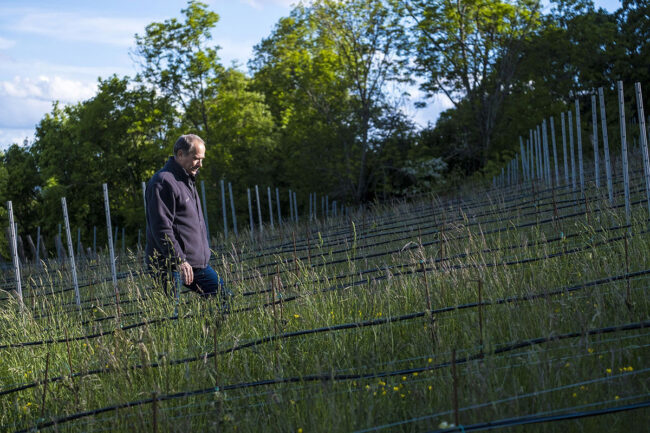
Raül Bobet
Above all, Castell d’Encus is an experiment, and one that has been approached with all the precision and insight of a research scientist. The goal, from the outset, was to discover the methodology behind reflective, subtle, non-explosive and low-alcohol wines with aging potential at an altitude where even the old-time winemakers claimed that grapes could not thrive.
But the grand experiment has a more ecological edge, and according to Bobet, “It was vital to us to pair an excellence in mountain winemaking with environmental protection. We want to channel new actions to increase biodiversity and create awareness as an example that everyone can get involved in taking care of the Earth. From our situation, we carry out actions in order to reduce the human impact on the land, the vineyard and the environment, without using herbicides or fungicides. We take advantage of the force of gravity and geothermal energy for certain tasks in the winery.”
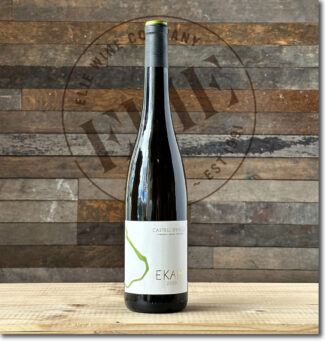 Castell d’Encus ‘Ekam’, 2020 Costers-del-Segre ‘Pallars Jussà’ ($45)
Castell d’Encus ‘Ekam’, 2020 Costers-del-Segre ‘Pallars Jussà’ ($45)
85% Riesling and 15% Albariño sourced from a cool, southwest-facing plot in the Pallars Jussà comarca, located between the Lleida Plain and the Pyrenees. Ekam means ‘divine unity’ in Sanskrit and offers an intense bouquet of kiwi, grapefruit, peach and ripe green apple and light kerosene notes which will develop and mature with age. Fermented in 2500 and 5000-liter tanks at low temperature, it is ‘trocken’, or dry. 2250 cases made.
Notebook …
Sugar: The Word That Cannot Speak Its Name
In Alsace, sugar has bedeviled winemakers and consumers for eons, although new regulations might be a little sugar to help the medicine go down.
According to Marc Hugel (Hugel & Fils): “When I first started in the trade 35 years ago, most of our wines contained three grams of sugar per liter or less. Now, most have more. I think there is correlation between our move toward sweet wines and low prices.”
Although dry wines is the purported goal of winemakers to meet a demand for food wine, warmer weather patterns have pushed ripeness, forcing producers to leave residual sugar to keep alcohol levels in check. Extra sugar can also hide; four grams per liter can seem bone dry with high enough acid levels. Another factor is that as wine ages, it tastes less sweet on the palate, a phenomenon that even Marc Hugel can’t explain. “Sometimes I leave residual sugar to keep alcohol moderate, but upon release six or seven years later, it tastes dry.”
The Grand Crus were defined at a time when getting to ripeness was problematic, so they are generally the sites that achieve greatest ripeness, often south-facing hillsides. An outdated regulation requires potential alcohol to reach 10% at harvest, but today it’s more of a problem to restrain alcohol. Even the most committed producers admit that it’s mostly impossible to get completely dry Pinot Gris or Gewürztraminer from Grand Cru sites: “Pinot Gris ripens very rapidly. Sometimes you say you harvest in the morning and it’s dry, you harvest in the afternoon and it’s sweet,” says Étienne Sipp (Louis Sipp). Marc Hugel adds, “Gewürztraminer will reach 13-14% when Riesling gets to 11%. It’s better to have 14% alcohol and 7 g/l sugar than 15% alcohol and bone dry.” Céline Meyer (Domaine Josmeyer) says, “If Gewürztraminer is completely dry it’s not agreeable because it’s too bitter.”
Now, a standardized sweetness guide will be required on all labels of AOP Alsace beginning with wines produced from the 2021 harvest. One option is for labels to contain a visual scale with sweetness levels and an arrow clearly pointing to one specific level. Slightly more information is available in the second option, a designation on each bottle of either Dry (sec): sugar content does not exceed 4 g/l; Medium-Dry (demi-sec): sugar content 4 g/l and 12 g/l; Mellow (moelleux): sugar content of the wine is between 12 g/l and 45 g/l and Sweet (doux): sugar content of the wine exceeds 45 g/l.
- - -
Posted on 2024.06.27 in France, Wine-Aid Packages, Alsace, Costers del Segre | Read more...
Hard Cidre is Built for The Heat: Light-bodied, Agile, Versatile and Low in Alcohol, Whether Sparkling or Still. 6-Bottle Pack for $129 (750 ml) ‘Amour’ – By the Dozen $99 (330-ml Bottles)
According to the ‘superstore’ timetable, once the Fourth of July is in the can, it’s time for us to start buying Halloween decorations. While we prefer to avoid feeding the retail rascal before its time, there is one beverage typically associated with autumn that is also perfectly appropriate for a summery, sweltering evening.
Fermented apple cider, a staple brew of our Founding Fathers, once filled a vital drink gap in regions too damp to grow beer barley and too cold to grow wine grapes, and chances are good that the signing of the Declaration of Independence was accompanied by plenty of toasts with cider.
In France, whose own revolution followed close on the heels of our own, ‘cidre’ is the trademarked term for fermented cider from Normandy and Brittany; it is generally effervescent and contains about 3–5 percent alcohol. Sweetness varies; although it is mainly produced dry (Brut), the sweeter style (Doux) has its fans. Due to longer, more complete fermentation, Brut cidre is generally on the higher end of the ABV scale.
Despite Its Ties to Fall, Hard Cidre Screams Summertime Sipper
Low in octane, effervescent, quaffable and refreshing, cidre offers a great alternative to beer for your outdoor summer tipple. At its most basic, it is fermented apple juice—you can make it yourself with a gallon from the orchard and a pinch of baker’s yeast. But like wine, it appears in multiple guises—tart, sweet, bitter, herbaceous, full of fireworks sparkles like a Roman candle or gently effervescent. The idea that cidre is one dimensional is not borne of experience, but of one-dimensional palates.
A plus for cidre’s place on the summertime table is its food-friendly versatility. Cidre’s acidity and tannin makes it the ideal foil for the grill or smoker—ribs, obviously (pork and apples have an innate affinity)—but virtually any sizzling, fatty cut of flesh will be complimented, and also roasted vegetables—the rootier the better. Cheese is another classic matchup for cidre, and Normandy is as known for its fromage as it is for its apples.
Once a standby in American taverns, the end of Prohibition in 1933 put a permanent dent in the American hard cider industry. Orchards were cut down and replaced by new varieties of sweet, table apples, and it was not until the 1990s that artisan cider makers began to rediscover their red, white and blue heritage.
Of course, France’s flag is also red, white and blue, and diverse cidres offered in this week’s package reflect the diversity from the most heralded ‘cidre centre’ in France; Normandy.
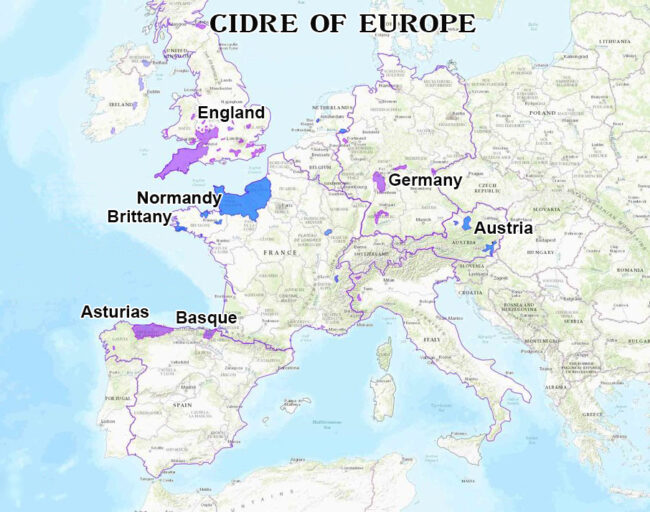
Styles: French Cidre Moves Beyond the Apple.
Keeving is Believing: Cidre relies on bittersweet and bittersharp apples rich in pectins and tannins and low in acid. As such, production tends to be a farmhouse undertaking and the art of cidre-making involves a filtering process known as keeving; keeving allows the natural pectin of the apples turn to a jelly-like consistency in cold temperatures over a week, where it rises to the top of the fermentation vessel as the heavy solids filter to the bottom of the tank and the jelly at the top. The remaining juice in the middle of the tank is then slowly fermented at cold temperatures with small quantities of yeast for 3-6 months.
The carbonation may be the result of a Champagne-like process or the artificial introduction of carbon dioxide at bottling.
Cidre de Normandie IGP was formalized in the year 2000; the cider must be made from apples, or a combination of apples and pears, each with its own profile and identity, giving cidre the same sort of unique varietal personality as wine has based on grapes.
Sweetness levels vary from dry to sweet (doux), and color from pale yellow to dark orange or rosé. There are also various technical specifications, including those regarding the types of apple or pear used. Tannin and acidity levels are also regulated. Many regulations vary depending on the category of fruit used, and the style of cider. Sweet ciders must have a minimum of 3.0 percent abv, while drier styles must reach 5.0 percent abv, or 5.5 percent for Cidre Bouché.
And then there is poiré, made from pears only; it differs from generic pear cider in that it’s made from designated varieties grown in Normandy. Pears are thought to have been grown here even before apple trees were cultivated.
Terroir: Cidre Takes Its Cue from Wine.
When fifteenth century Cistercian monks in Burgundy first began to document the difference in wine quality from various vineyards, they believed that it was a sign from above; that terroir expressed the variegated contours of God’s creation. Although in the modern era, the science of fermentation and a winemaker’s skill in applying and refined production methods have supplanted a monastic explanation for the differences in wine, the quest for a ‘sense of place’ remains alive and well.
In cider production—especially when compared to wine—terroir has traditionally had a less firm hold on the thought processes. For most of the world, cider is a year-long industrial manufacturing process, while in France, especially in controlled appellations, cidre is typically made seasonally, following the apple harvest. But like wine from grapes, cidre can be redolent not only of the fruit used, but of the locality where it’s grown; the soil, the aspect, the geography and the climate of the orchards.
This is precisely what winemakers call terroir.
L’AOC (controlled designation of origin laws) ensures that the product comes from a specified geographical area and is fermented accordingly to a specific savoir-faire. For cidre, there currently four AOCs: Cornouaille, Cotentin, Pays d’Auge. Domfront (for perry; cidre made from pears). Du Perche, a region in lower Normandy about ninety minutes from Paris, is currently awaiting final AOC status.
Cidre in Normandy: The Apple of the Region’s Eye!
Normandy, which most of us associate with the D-Day invasion of 1944, gets a failing grade in being French: They tend to love Americans. They also love apples, and harvest nearly half a million a year, many (but not all) destined to be transformed into Norman Cidre. Throughout the regions of Calvados, Eure, Manche, Orne and Seine-Maritime, cidre is king, although the menu also includes world-class apple juice, pectin jelly and phenomenal apple-based pastries. In the 9th century, Charlemagne ordered more apple trees to be planted in the region, which is too far north and too sunshine-challenged for grape cultivation.
The Norman apple harvest begins in mid-September, when ripe fruit begins to fall from trees naturally. More than 200 varieties of apples are legally permitted; the most common is the Frequin Rouge, followed by distinctive Michelin and Muscadet de Dieppe.
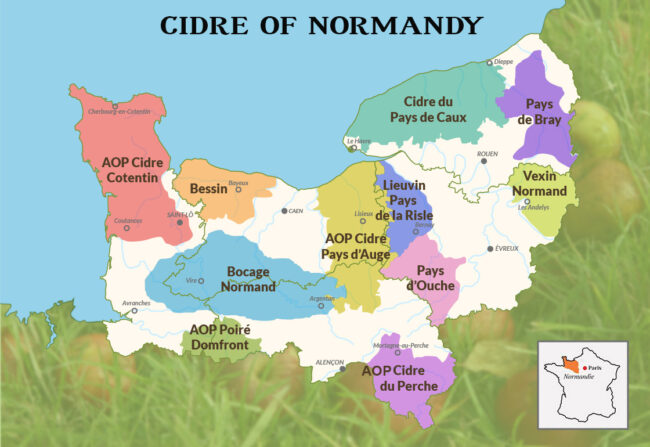
Marie-Agnès Hérout
Maison Hérout
The Contenin Peninsula, part of the staging area for Operation Overlord (the codename of the Invasion of Normandy) pokes its nose far into the English Channel, and was chosen as a landing site for this very reason. Maison Hérout, known for producing some of the driest and most complex ciders made anywhere, has seen many such incursions—the Hérout family tree goes back to the Vikings, who settled in this area around the ninth and tenth centuries. In fact, many Cotentin village names in the still flaunt Norse roots, like the beautiful Briquebec and Quettetot.
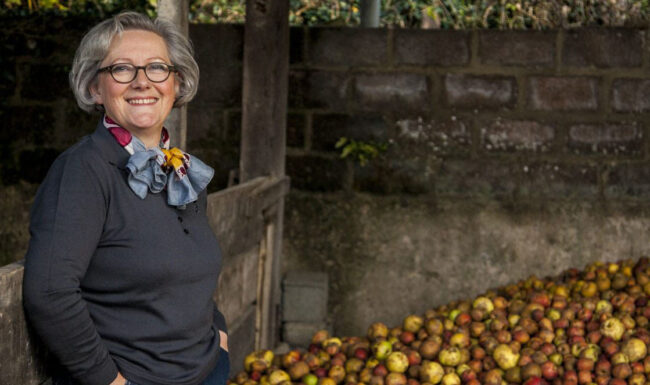
Marie-Agnès Hérout, Maison Hérout
© Hérout Cidres & Calvados
The Hérout estate is located near the town of Auvers, where apples thrive in a lush oceanic climate. The Hérout family began producing cider in the 1940s; today, Marie-Agnès Hérout has taken over the farm and remains true to her heritage by producing some of the finest ciders available from this region. After picking, the apples are grated, macerated, and then pressed with the help of a rack press dating back to 1920, whereupon the juice is left to ferment for four to seven months, often in used Calvados barrels.
Marie-Agnès also continues the family tradition of planting apple trees for future generations and in 2000, began a campaign with the Syndicat de Promotion du Cidre du Cotentin to earn the region’s certification for Appellation d’Origine Contrôlée Cotentin status. In May of 2016, after 16 years of hard work and perseverance, the quest succeeded.
 1 Maison Hérout ‘Micro – Cuvée No 1’, 2019 AOP Cotentin ($23) (750 ml, Effervescent Brut – Cidre Bio 6.5% abv)
1 Maison Hérout ‘Micro – Cuvée No 1’, 2019 AOP Cotentin ($23) (750 ml, Effervescent Brut – Cidre Bio 6.5% abv)
A fizzy, bright gold organic cidre aged for three months in Calvados barrels (leading to the slightly higher alcohol content). It shows aromas of fallen lemon and earth with a lightly tannic, vibrant and compelling body that shows brisk dried peach, hay and parchment on the finish.
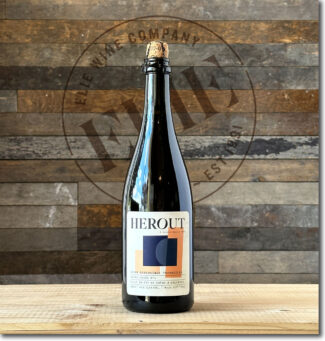 2 Maison Hérout ‘Micro – Cuvée No 1’, 2020 AOP Cotentin ($23) (750 ml, Tranquil – Cidre Bio 5.5% abv)
2 Maison Hérout ‘Micro – Cuvée No 1’, 2020 AOP Cotentin ($23) (750 ml, Tranquil – Cidre Bio 5.5% abv)
A still version of the above, made as an experiment that proved to be a widely popular success. Aged for 3 months in barrels that previously held Calvados.
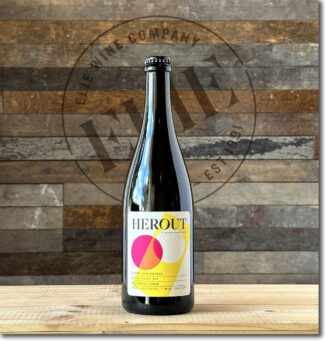 3 Maison Hérout ‘Micro – Cuvée No 4’, 2020 AOP Cotentin ($23) (750 ml, Effervescent – Cidre Bio 4% abv)
3 Maison Hérout ‘Micro – Cuvée No 4’, 2020 AOP Cotentin ($23) (750 ml, Effervescent – Cidre Bio 4% abv)
No. 4 a new cuvée produced entirely from rare acidic apples grown in the Contentinois orchards with no addition of bitter or sweet apples. It is barrel-aged for several months before the ‘prise de mousse’ captures the sparkle. Notes of rich apple must, orange, honey, leather, and earth lead to a tannic, slightly bitter finish. Only 9 cases available.
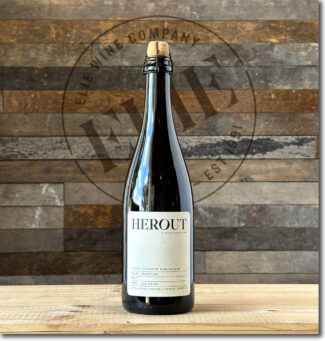 4 Maison Hérout ‘Cuvée Tradition’, 2020 AOP Cotentin ($18) (750 ml, Effervescent – Cidre Bio 5% abv)
4 Maison Hérout ‘Cuvée Tradition’, 2020 AOP Cotentin ($18) (750 ml, Effervescent – Cidre Bio 5% abv)
Bright gold color. Frothy bubbles. Aromas of picked apple. Slightly earthy with a tannic, vibrant, fruity light-to-medium body and compelling hints of minerality.
‘Amour’
By the Dozen ($99)
Cidre with a heart of gold, produced in the Cotentin Peninsula using artisanal techniques perfected by Maison Hérout since 1946—show the love by picking up a case, 12 of 330 ml bottles.
This is a good time for a shout out to our cidre importer Jon-David Headrick, whose rural Tennessee roots give him a particularly keen palate for apple cider while his many years in France have taught him how to uncork the best.
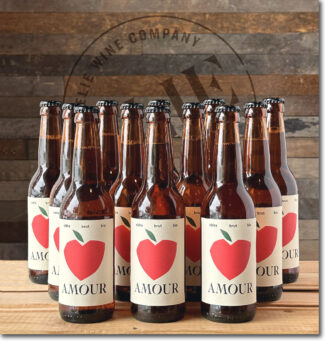 Maison Hérout ‘Amour’, IGP Cidre de Normandie – 4.5% abv – (330 ml)
Maison Hérout ‘Amour’, IGP Cidre de Normandie – 4.5% abv – (330 ml)
This is the only non-AOP cidre made by Hérout; it includes fruit that originates just outside the appellation and is exclusively bottled in 330 ml bottles. The juice is aged in a tank and bottled after about four months. Organic and slightly off-dry with the second fermentation occurring in the bottle; the cidre has an appealing low alcohol content. It is redolent of ripe apples in pastry, with hints of orange citrus, forest floor, bitter coffee bean and apricot on the finish.
Cyril Zangs
Cyril Zangs
Jazz-aficionado Cyril Zangs was a book sales rep in Paris before returning to his native Normandy and jumping into the cidre game with both feet. Of the 200 apple varieties approved for cidre making, he uses 69 of them, and in keeping with the natural wine movement, he ferments on native yeasts, unfiltered and without added sulphur.
After apple quality, Zangs says, it is all about process: “Each of our varieties possesses a particular characteristic (sweet, bittersweet, bitter, slightly acidic or sour) and are harvested from high-stem orchards which range from fifteen to sixty years old. We harvest by hand between early October and mid-December, when apples are the ripest. Our manual selection process ensures that only the best apples are picked—we then separate the apples by variety and store them in our barns to continue ripening for up to six weeks.”
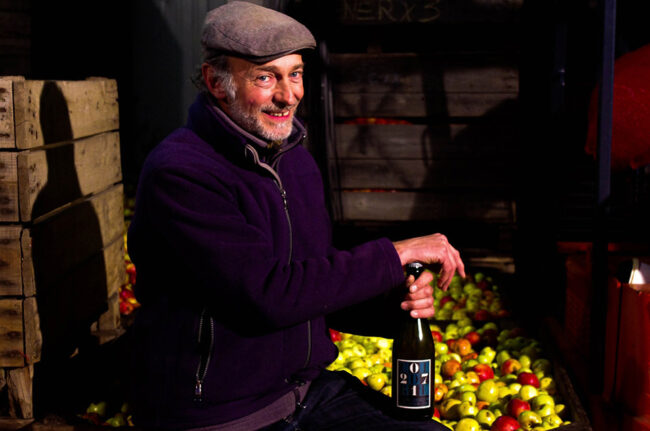
Cyril Zangs
What happens next? In his own words: “Once sorted to obtain the best flavor balance, the apples are grated to create a marc. This is put through to our hydraulic press and the juice is transferred to vats, and racked during the 6 months long fermentation process. It is left undisturbed apart from infrequent racking, or ‘soutirages’. The unfiltered cidre is bottled with no sulfites added and stocked horizontally for two to three months to capture the sparkle. The bottles are then stored on A-racks and regularly turned for three weeks; we then disgorge every bottle by hand, a process that naturally removes the sediment. Each bottle is topped up with the same disgorged cider, with nothing else added.”
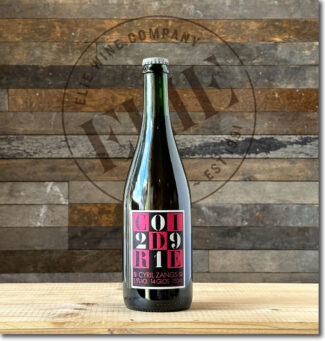 5 Cyril Zangs ’14 Glos’, 2019 IGP Cidre de Normandie ($27) (750 ml, Effervescent Brut – Cidre Bio 5.5% abv)
5 Cyril Zangs ’14 Glos’, 2019 IGP Cidre de Normandie ($27) (750 ml, Effervescent Brut – Cidre Bio 5.5% abv)
From the tiny commune of Glos in Calvados, Cyril Zangs produces this IGP cidre—IGP, for reference, is an EU quality classification that became valid in 2009; it means Indication Géographique Protégée and supplanted Vin de Pays. ‘14 Glos’ shows a creamy and rich texture, and displays notes of star anise, orange peel and unsurprisingly, bittersweet apple.
Guillaume & Thierry Desfrièches
Cidrerie Léon Desfrièches et Fils
‘Le Père Jules’
“In 1923, my father distilled his first Calvados”, says Léon Desfrièches, current head of the Desfrièches clan, and who has (since 1949) carried on the cidre and distilling traditions put in place by ‘Père Jules.’ In 1976, Léon’s eldest son Thierry joined him, followed by Guillaume, Thierry’s son, in 2002. Jules, Léon, Thierry and Guillaume—four generations of Desfrièches.
The Le Père Jules farm, Clos de la Pommeraye is made of a number of orchards spread over one hundred acres, with ten acres of pear trees. Extensive production is based on a with a tree density of around 80 to 100 trees per hectare.
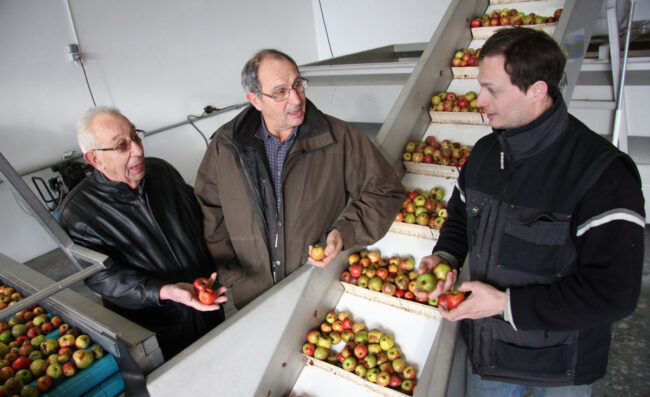
Léon, Thierry & Guillaume Desfrièches, Cidrerie Léon Desfrièches et Fils
Located in the Norman village of Saint Desir, the flagship cidre is made in honor of the late patriarch Jules. Now 85, Léon says: “I would have really liked my father sees what we have accomplished. As for myself, I hope I am like my Calvados: Serene and not afraid of aging with elegance, grace and roundness.”
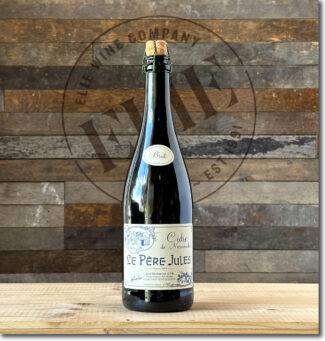 6 Cidrerie Léon Desfrièches et Fils ‘Le Père Jules’, IGP Cidre de Normandie ($16) (750 ml, Effervescent Brut – 5% abv)
6 Cidrerie Léon Desfrièches et Fils ‘Le Père Jules’, IGP Cidre de Normandie ($16) (750 ml, Effervescent Brut – 5% abv)
Very mature apple notes do homage to the Father Jules, showing white flowers and honey. Upfront in the first mouth, it develops an earthy, rich and fruity bouquet with interesting tannins for a long aftertaste.
- - -
Posted on 2024.06.26 in Cidre, France, Wine-Aid Packages | Read more...
Featured Wines
- Notebook: A’Boudt Town
- Saturday Sips Wines
- Saturday Sips Review Club
- The Champagne Society
- Wine-Aid Packages
Wine Regions
Grape Varieties
Albarino, Albarín Blanco, Albarín Tinto, Albillo, Aleatico, Aligote, Arbanne, Aubun, Barbarossa, barbera, Biancu Gentile, bourboulenc, Cabernet Franc, Caino, Caladoc, Calvi, Carcajolu-Neru, Carignan, Chablis, Chardonnay, Chasselas, Cinsault, Clairette, Corvina, Counoise, Dolcetto, Erbamat, Ferrol, Frappato, Friulano, Fromenteau, Gamay, Garnacha, Garnacha Tintorera, Gewurztraminer, Graciano, Grenache, Grenache Blanc, Groppello, Juan Garcia, Lambrusco, Loureira, Macabeo, Macabou, Malbec, Malvasia, Malvasia Nera, Marcelan, Marsanne, Marselan, Marzemino, Mondeuse, Montanaccia, Montònega, Morescola, Morescono, Moscatell, Muscat, Natural, Niellucciu, Parellada, Patrimonio, Pedro Ximénez, Petit Meslier, Petit Verdot, Pineau d'Aunis, Pinot Blanc, Pinot Gris, Pinot Meunier, Pinot Noir, Pouilly Fuisse, Pouilly Loche, Poulsard, Prieto Picudo, Riesling, Rondinella, Rose, Rousanne, Roussanne, Sagrantino, Sauvignon Blanc, Savignin, Sciacarellu, Semillon, Souson, Sparkling, Sumoll, Sylvaner, Syrah, Tannat, Tempranillo, Trebbiano, Trebbiano Valtenesi, Treixadura, Trousseau, Ugni Blanc, vaccarèse, Verdicchio, Vermentino, Xarel-loWines & Events by Date
- July 2024
- June 2024
- May 2024
- April 2024
- March 2024
- February 2024
- January 2024
- December 2023
- November 2023
- October 2023
- September 2023
- August 2023
- July 2023
- June 2023
- May 2023
- April 2023
- March 2023
- February 2023
- January 2023
- December 2022
- November 2022
- October 2022
- September 2022
- August 2022
- July 2022
- June 2022
- May 2022
- April 2022
- March 2022
- February 2022
- January 2022
- December 2021
- November 2021
- October 2021
- September 2021
- August 2021
- July 2021
- June 2021
- May 2021
- April 2021
- March 2021
- February 2021
- January 2021
- December 2020
- November 2020
- October 2020
- September 2020
- August 2020
- July 2020
- June 2020
- May 2020
- April 2020
- March 2020
- February 2020
- January 2020
- December 2019
- November 2019
- October 2019
- September 2019
- August 2019
- July 2019
- June 2019
- May 2019
- April 2019
- March 2019
- February 2019
- January 2019
- December 2018
- November 2018
- October 2018
- September 2018
- August 2018
- July 2018
- June 2018
- May 2018
- April 2018
- March 2018
- February 2018
- January 2018
- December 2017
- November 2017
- October 2017
- September 2017
- August 2017
- July 2017
- June 2017
- May 2017
- April 2017
- March 2017
- February 2017
- January 2017
- December 2016
- November 2016
- October 2016
- September 2016
- August 2016
- July 2016
- June 2016
- May 2016
- April 2016
- March 2016
- February 2016
- January 2016
- December 2015
- November 2015
- October 2015
- September 2015
- August 2015
- July 2015
- June 2015
- May 2015
- April 2015
- March 2015
- February 2015
- January 2015
- December 2014
- November 2014
- October 2014
- September 2014
- August 2014
- July 2014
- June 2014
- April 2014
- March 2014
- February 2014
- January 2014
- December 2013
- November 2013
- October 2013
- September 2013
- August 2013
- July 2013
- June 2013
- May 2013
- April 2013
- March 2013
- February 2013
- January 2013
- December 2012
- November 2012
- October 2012
